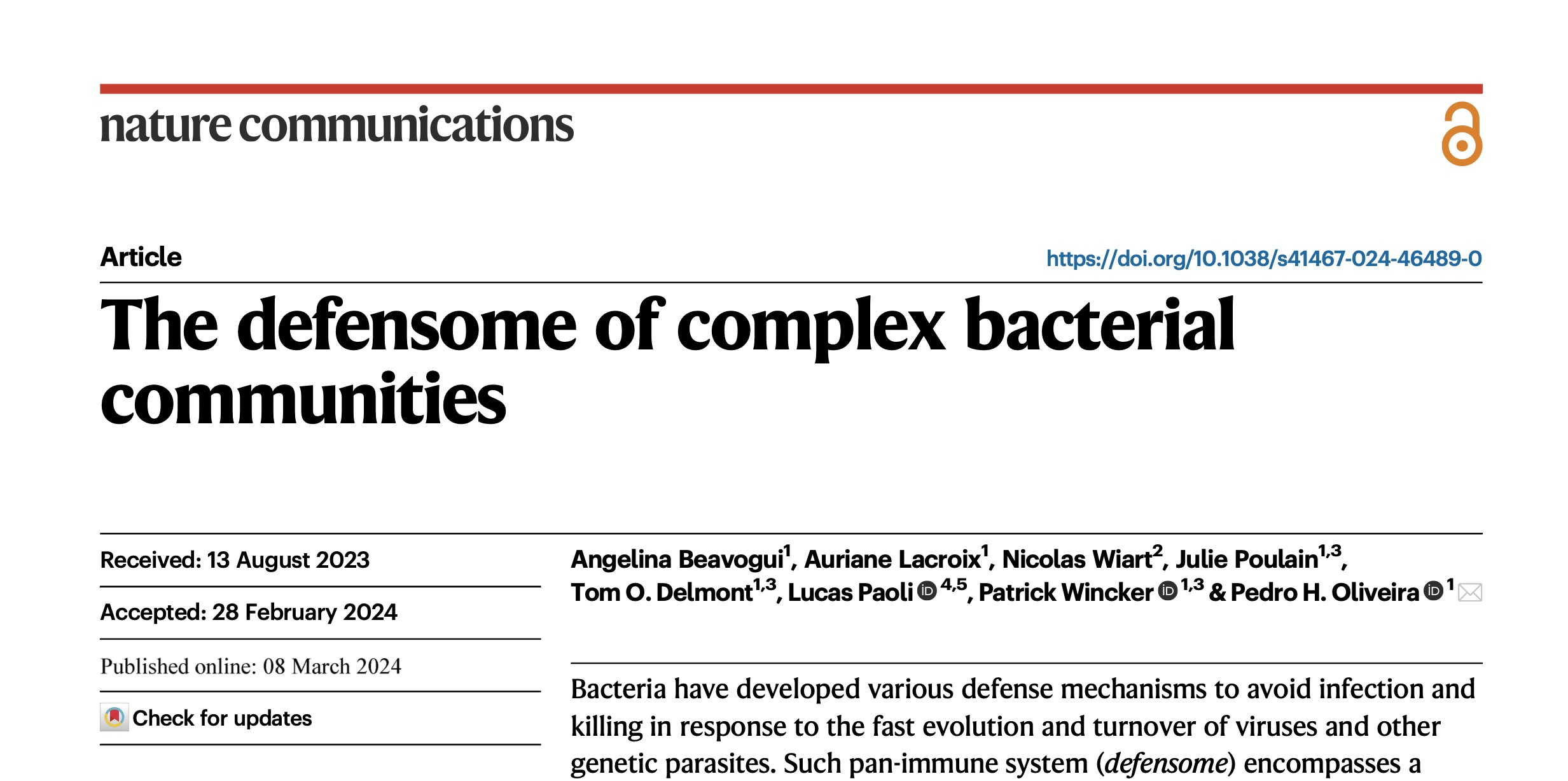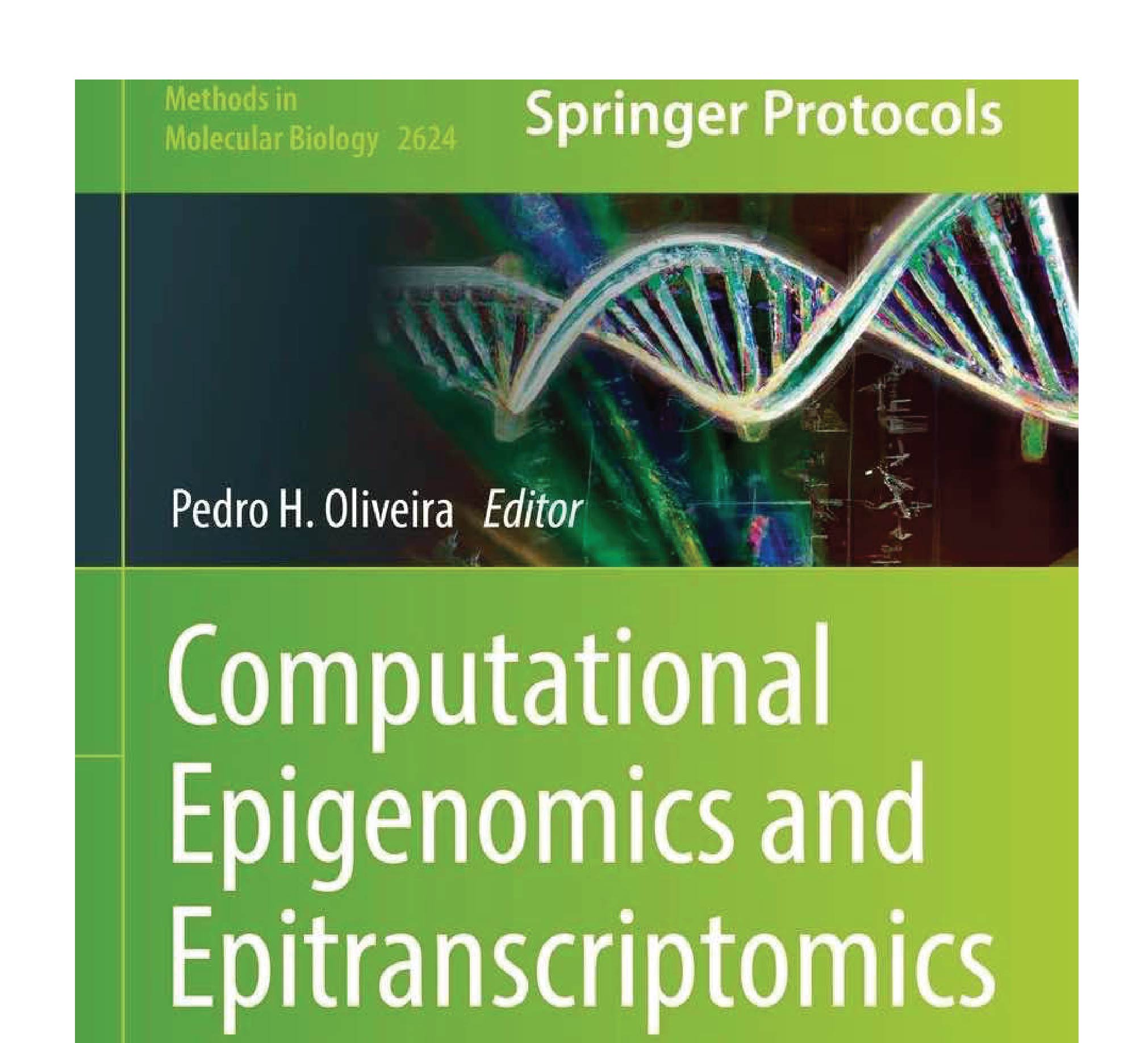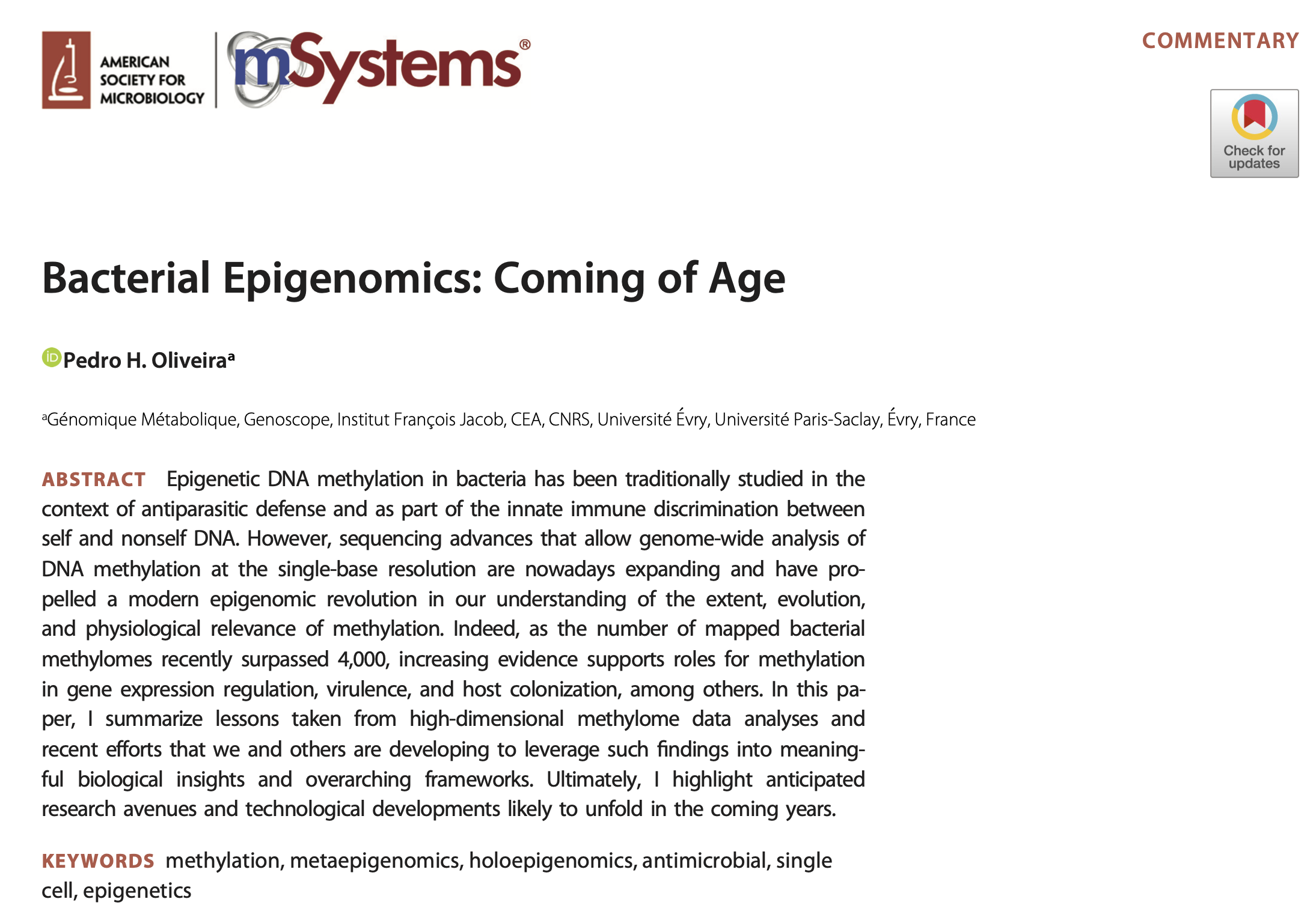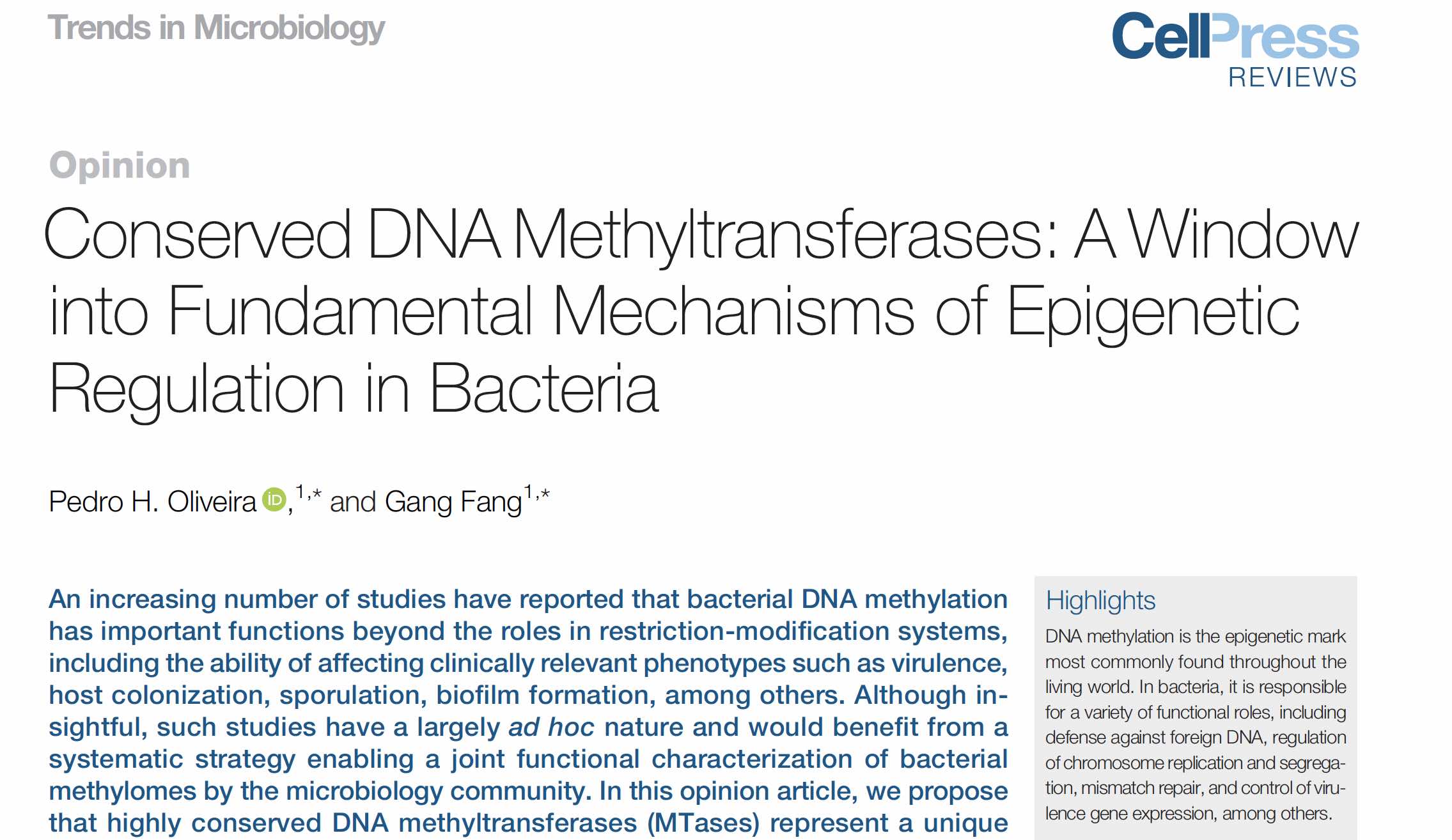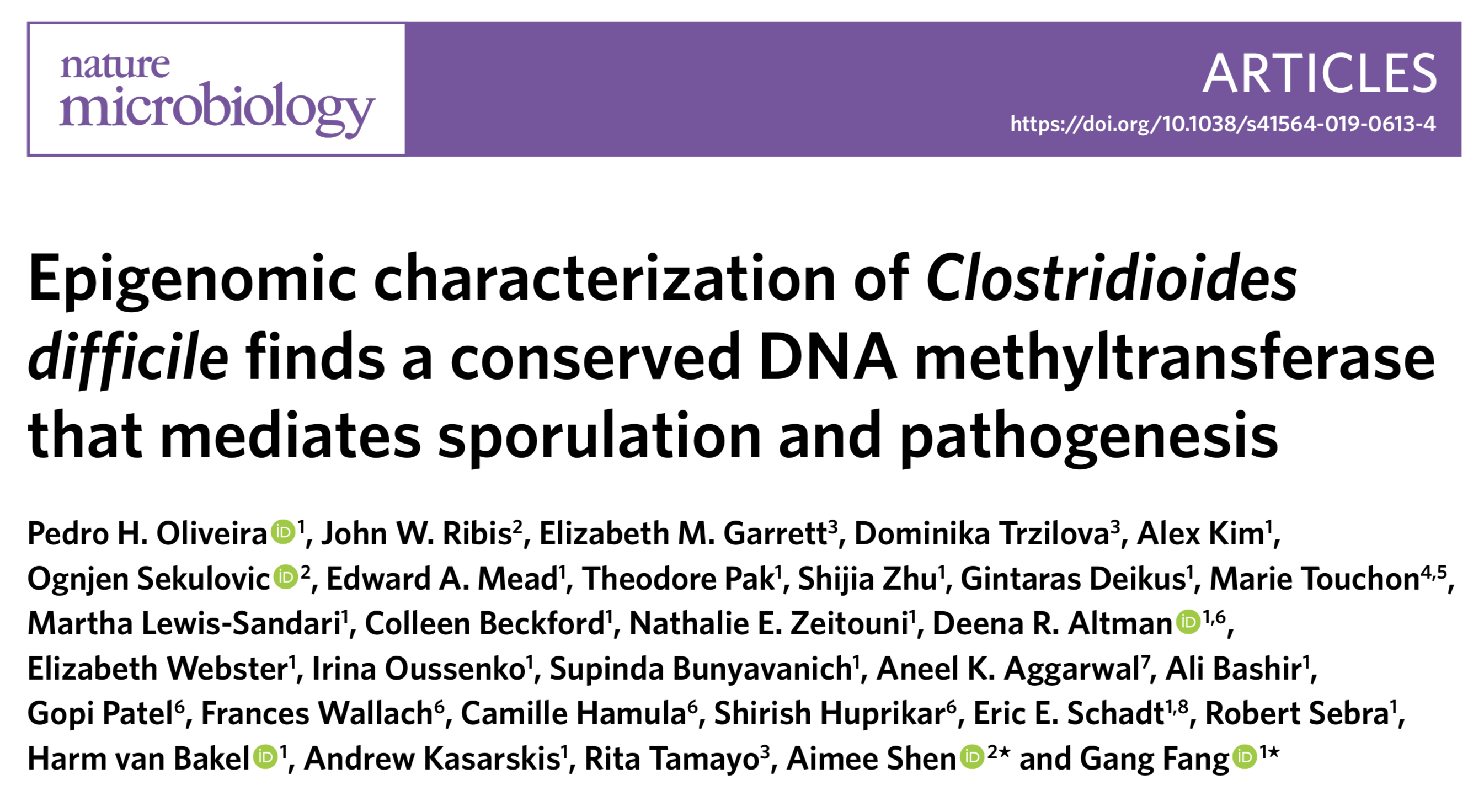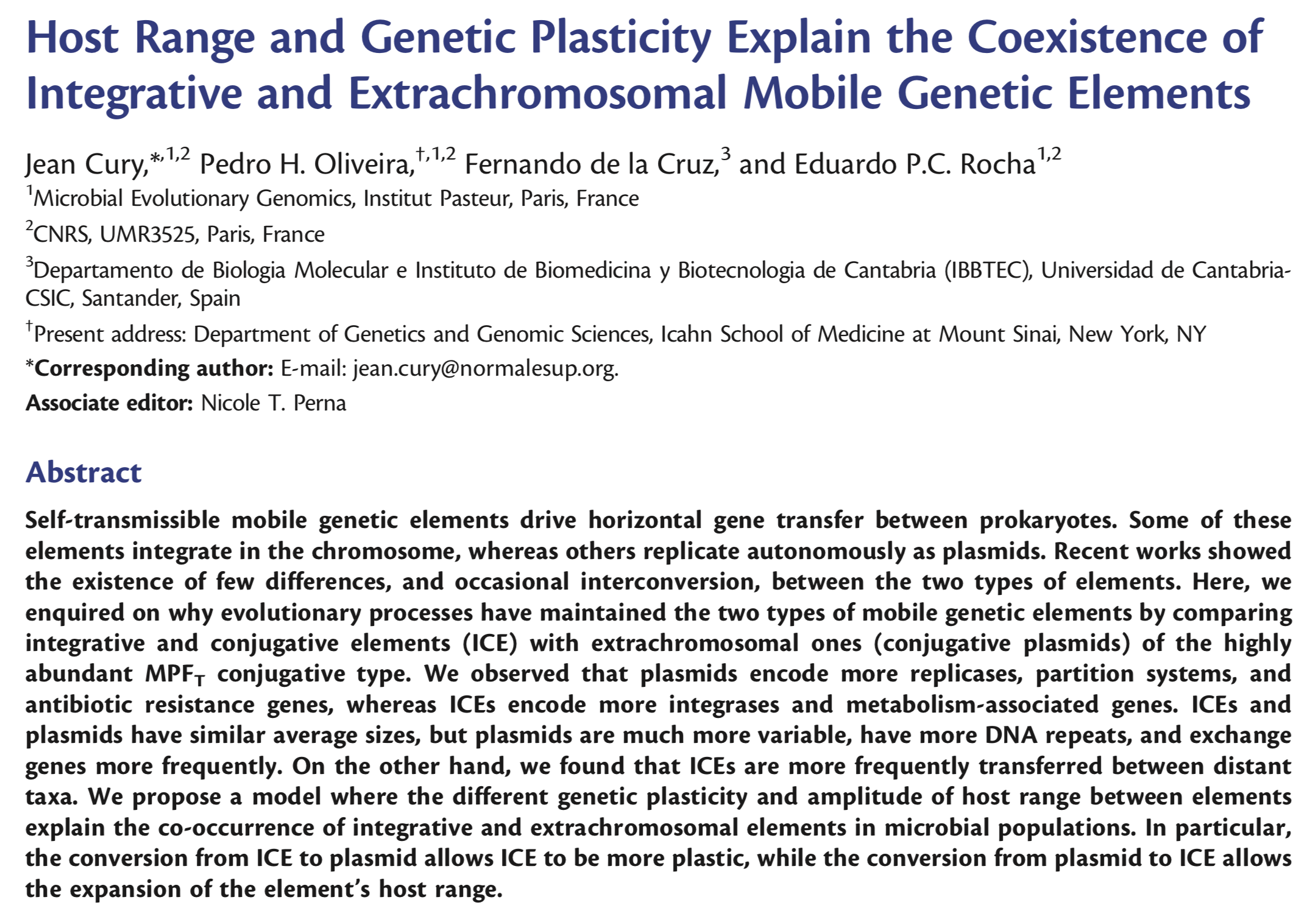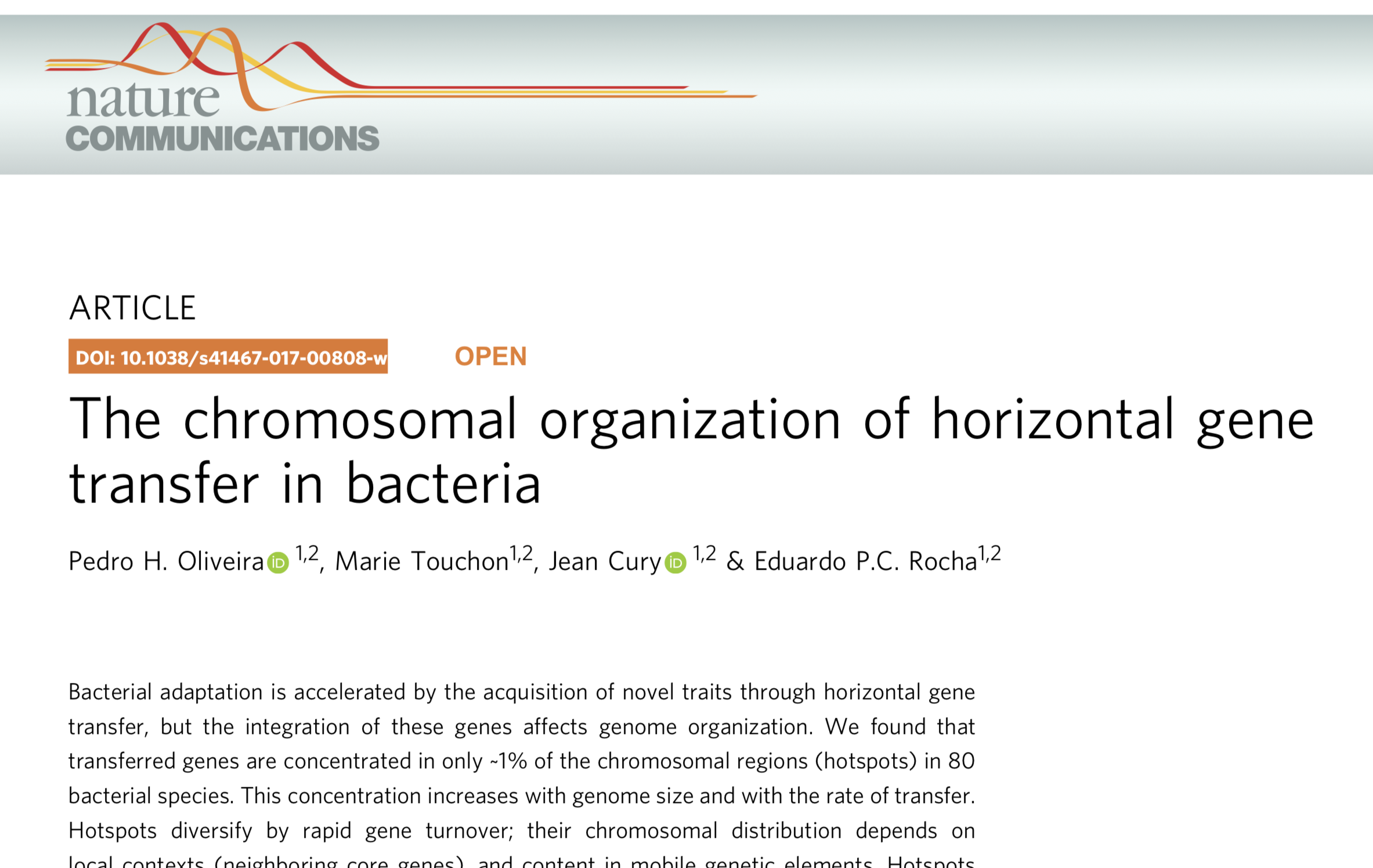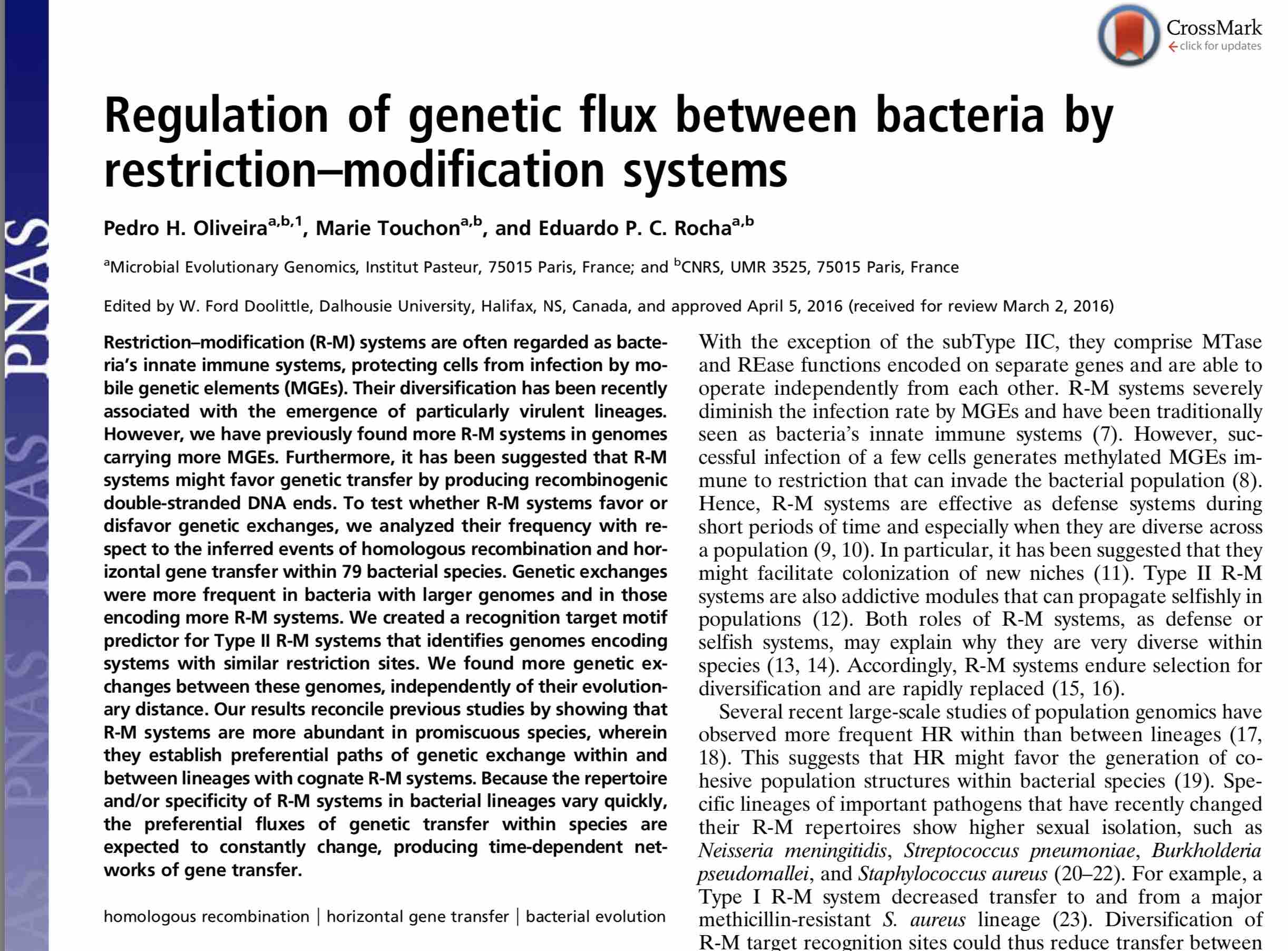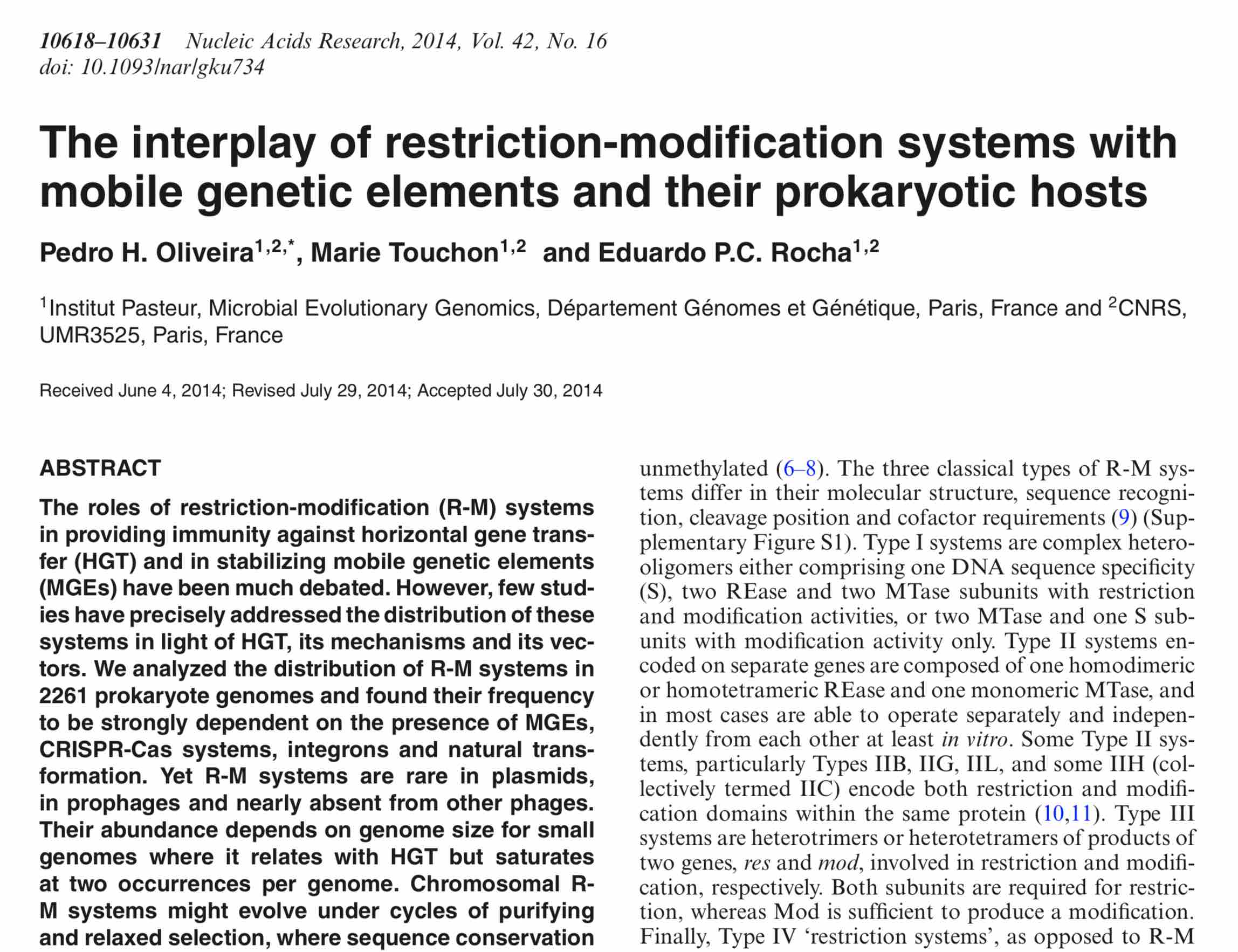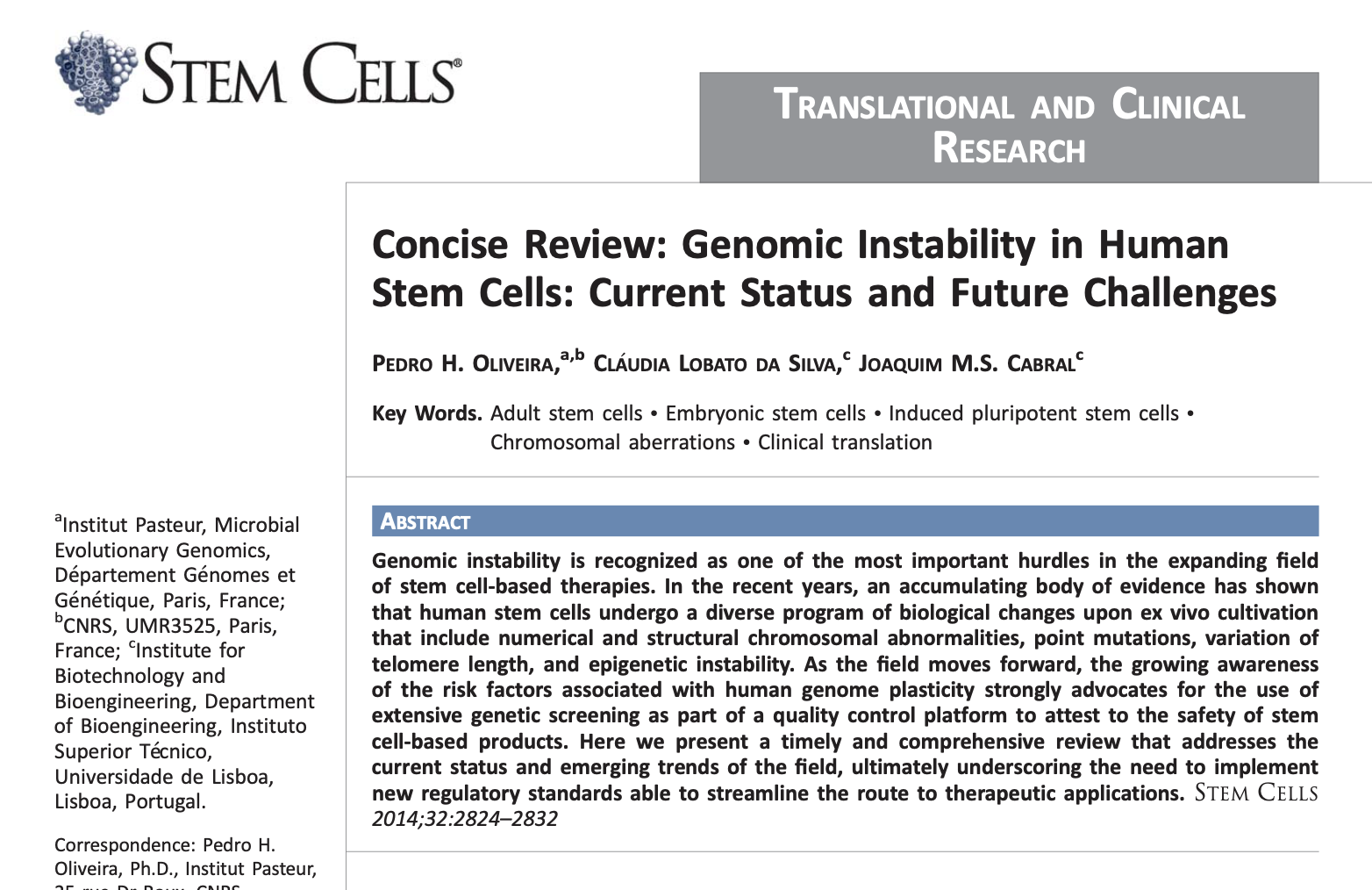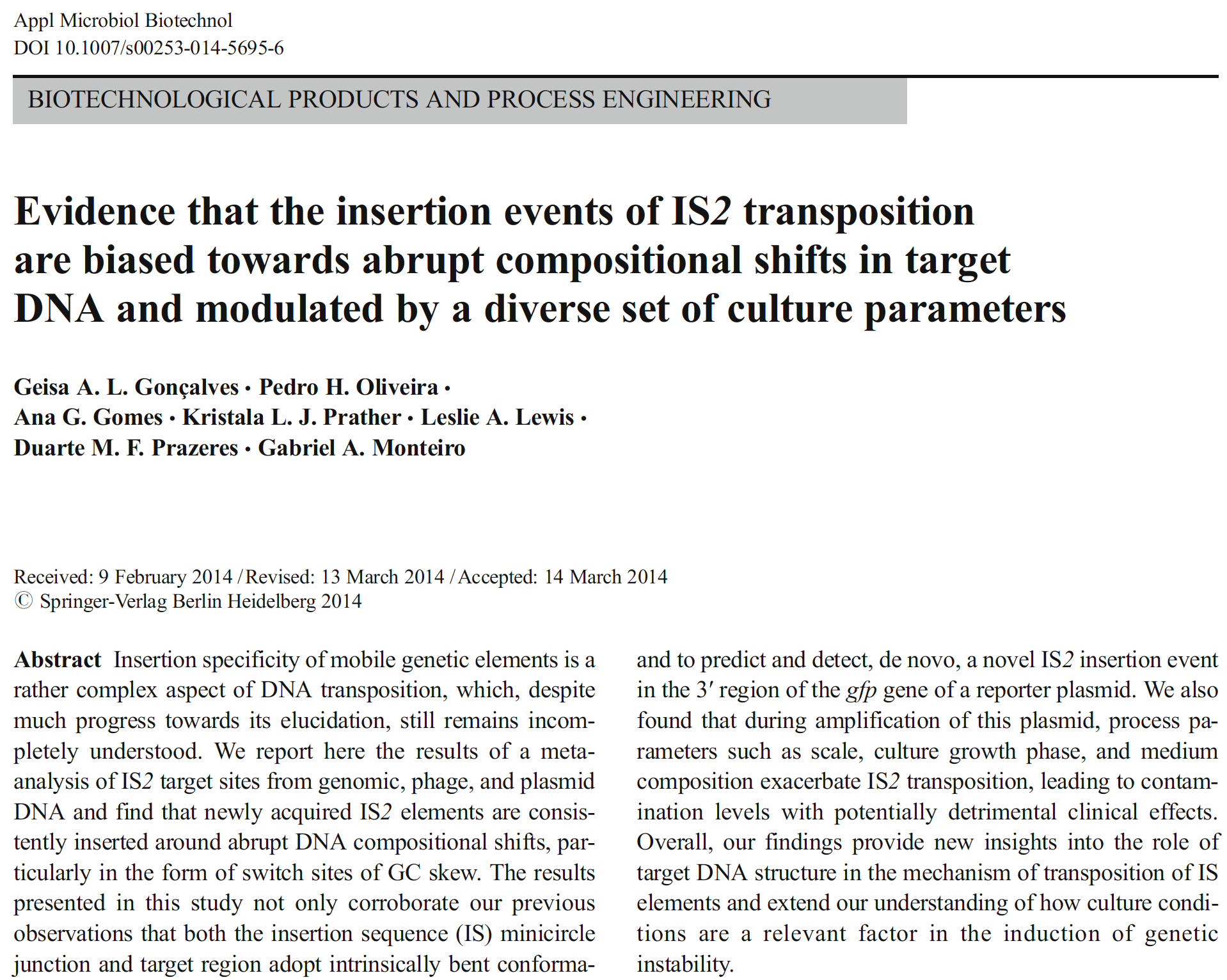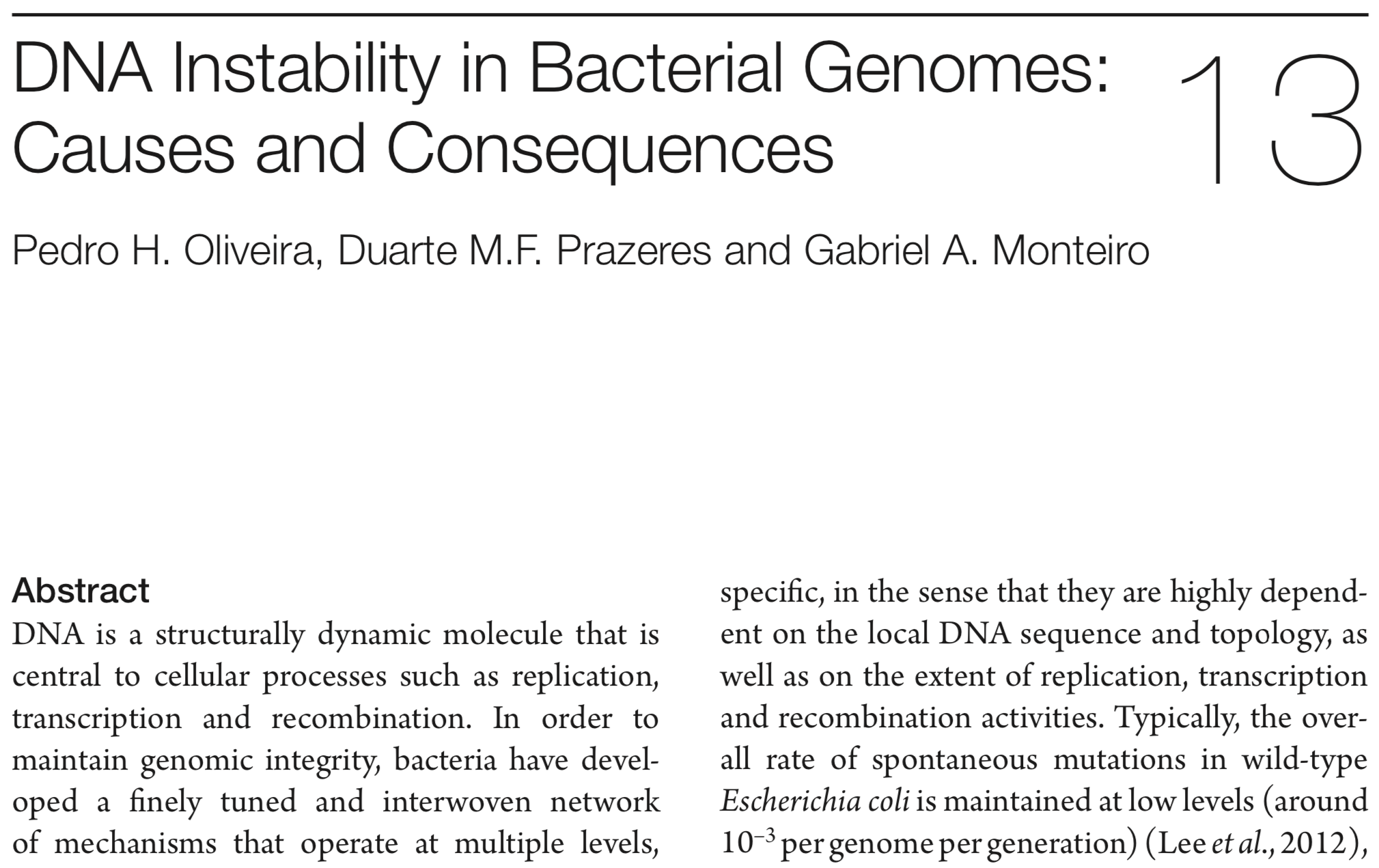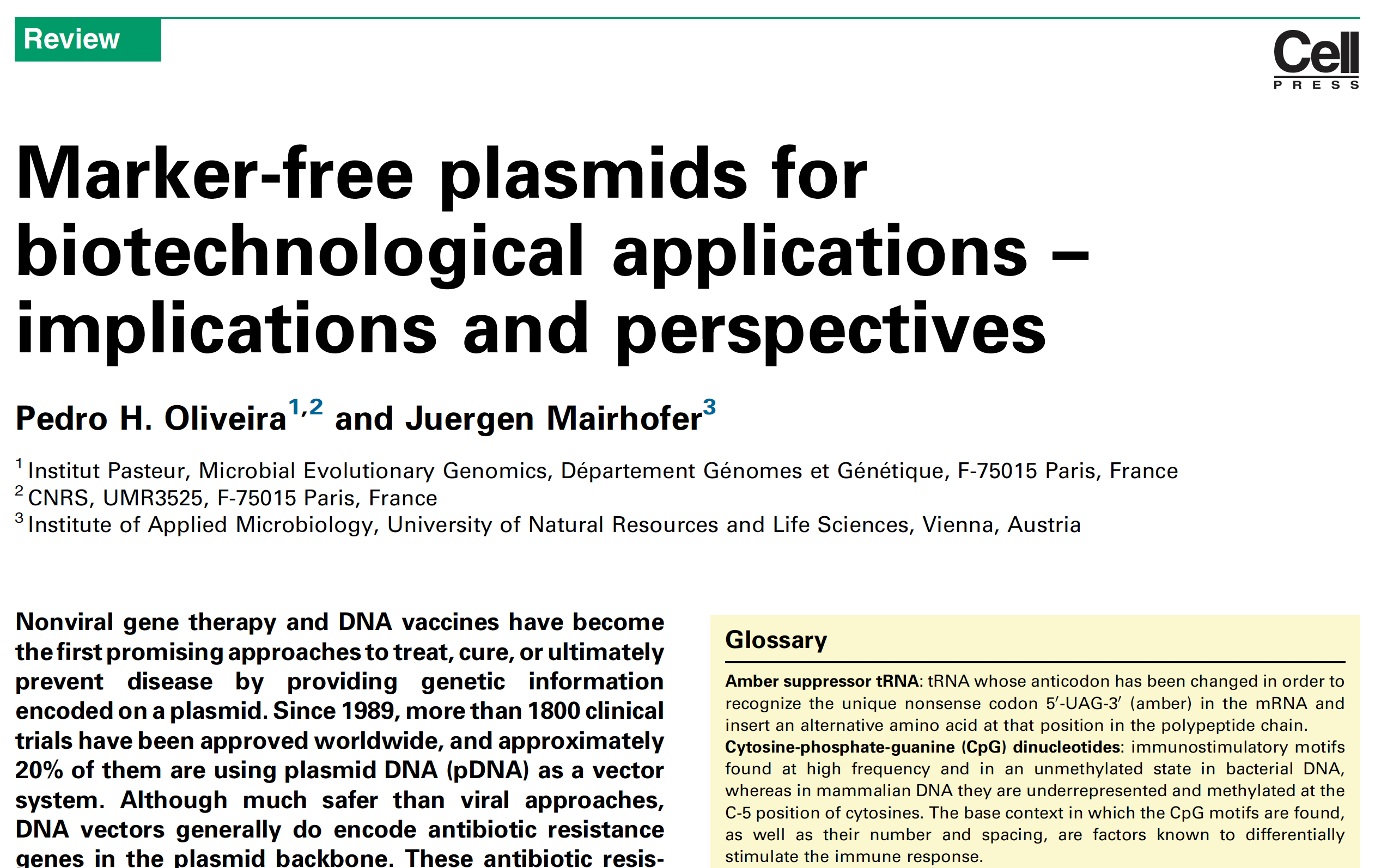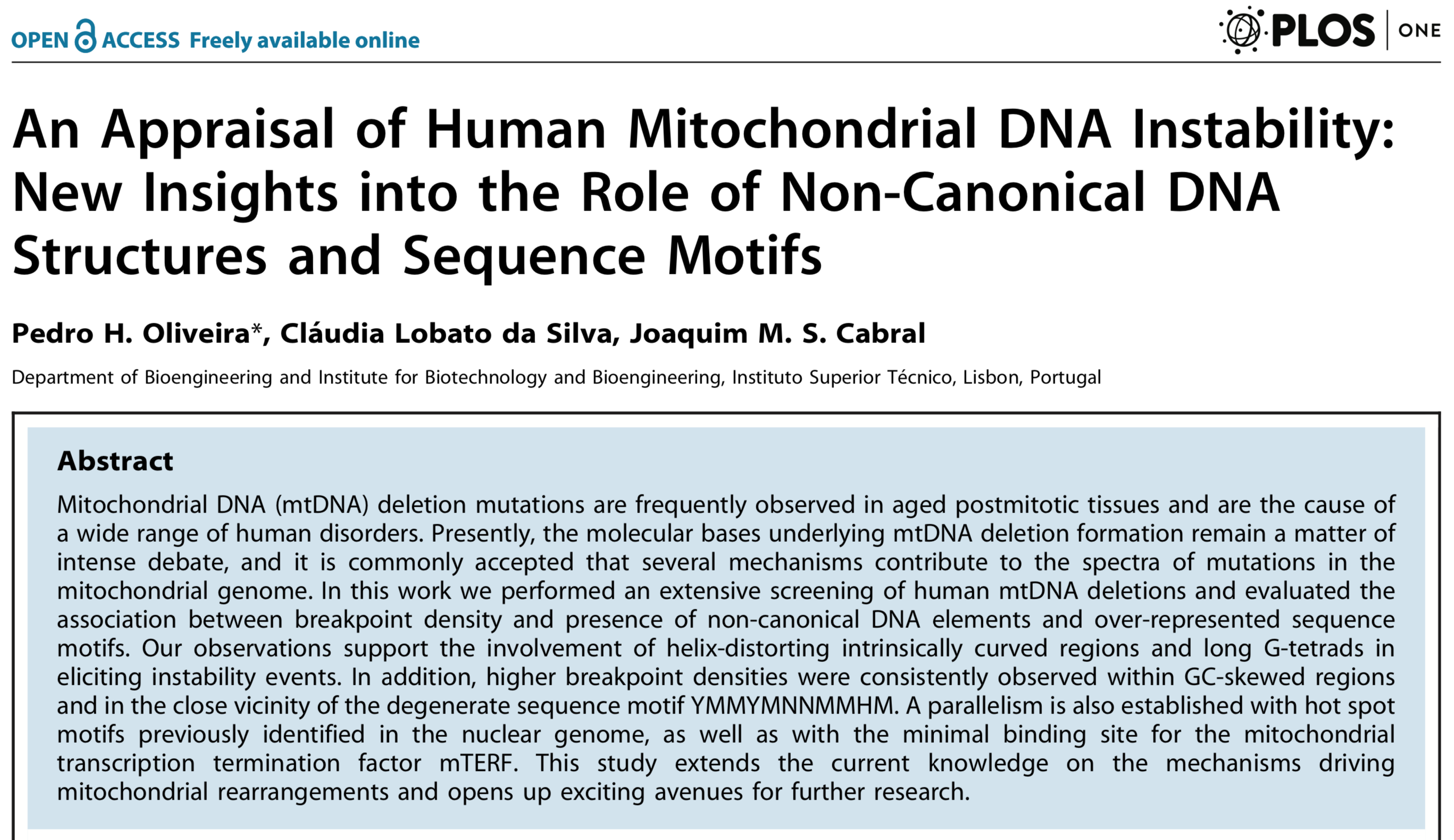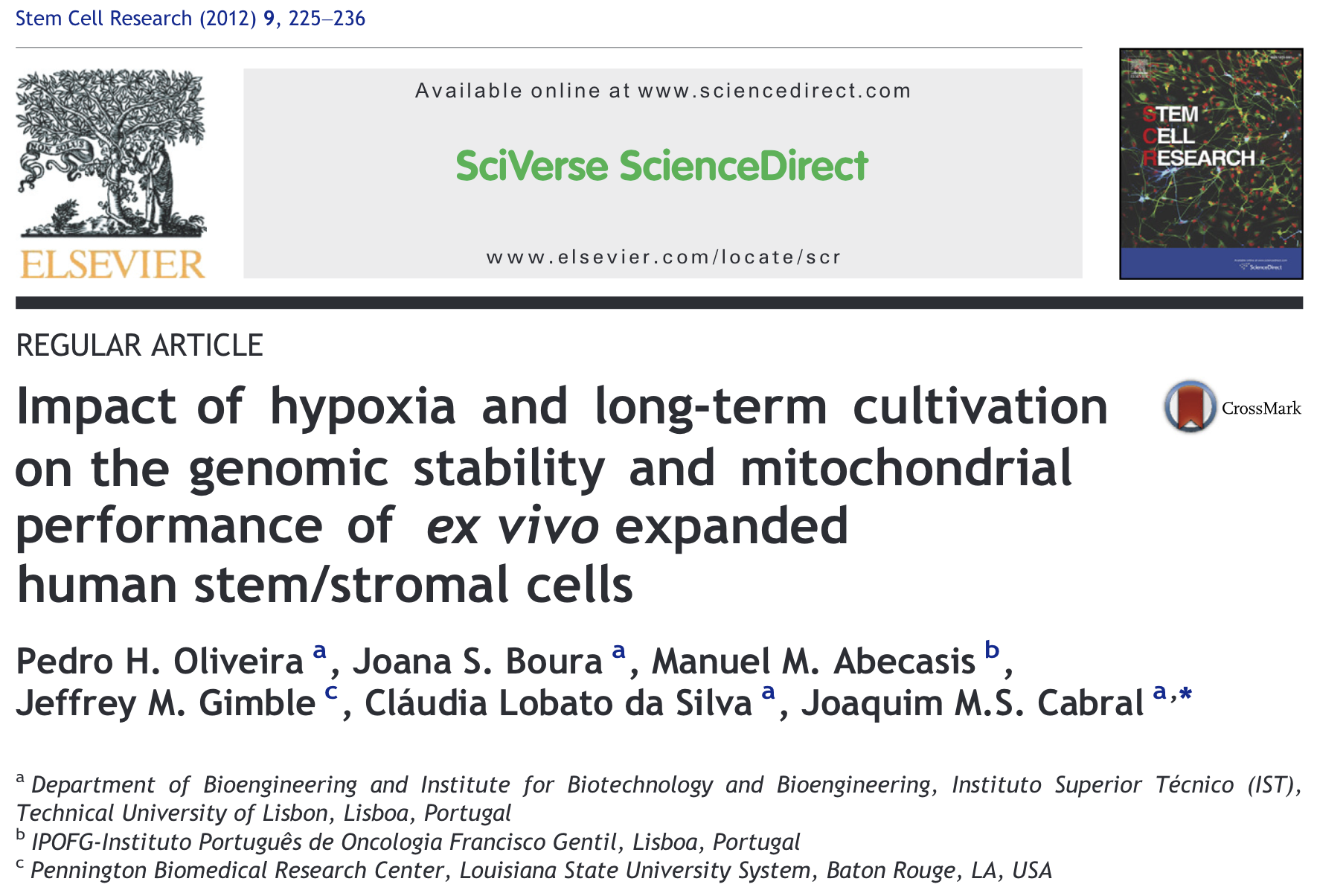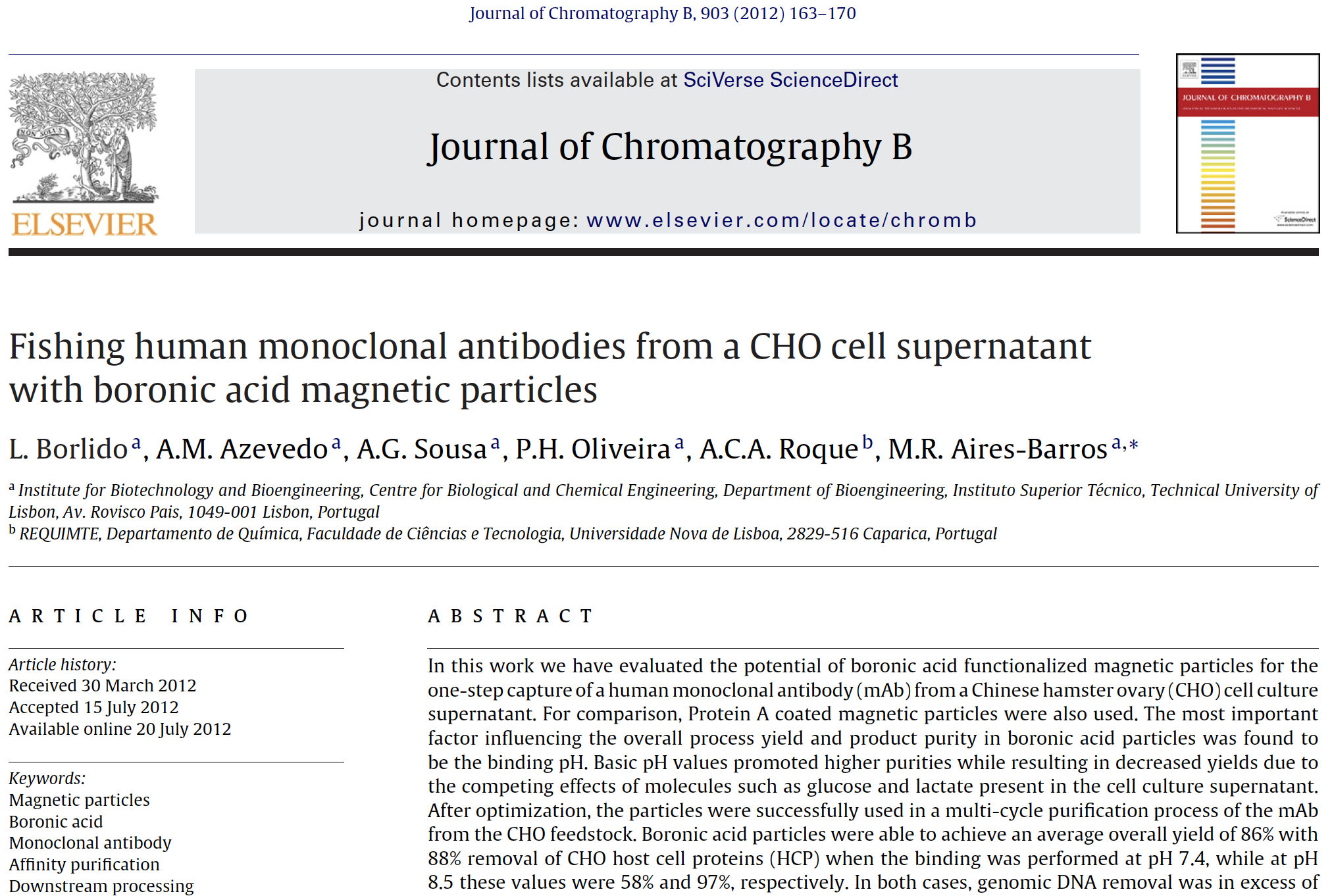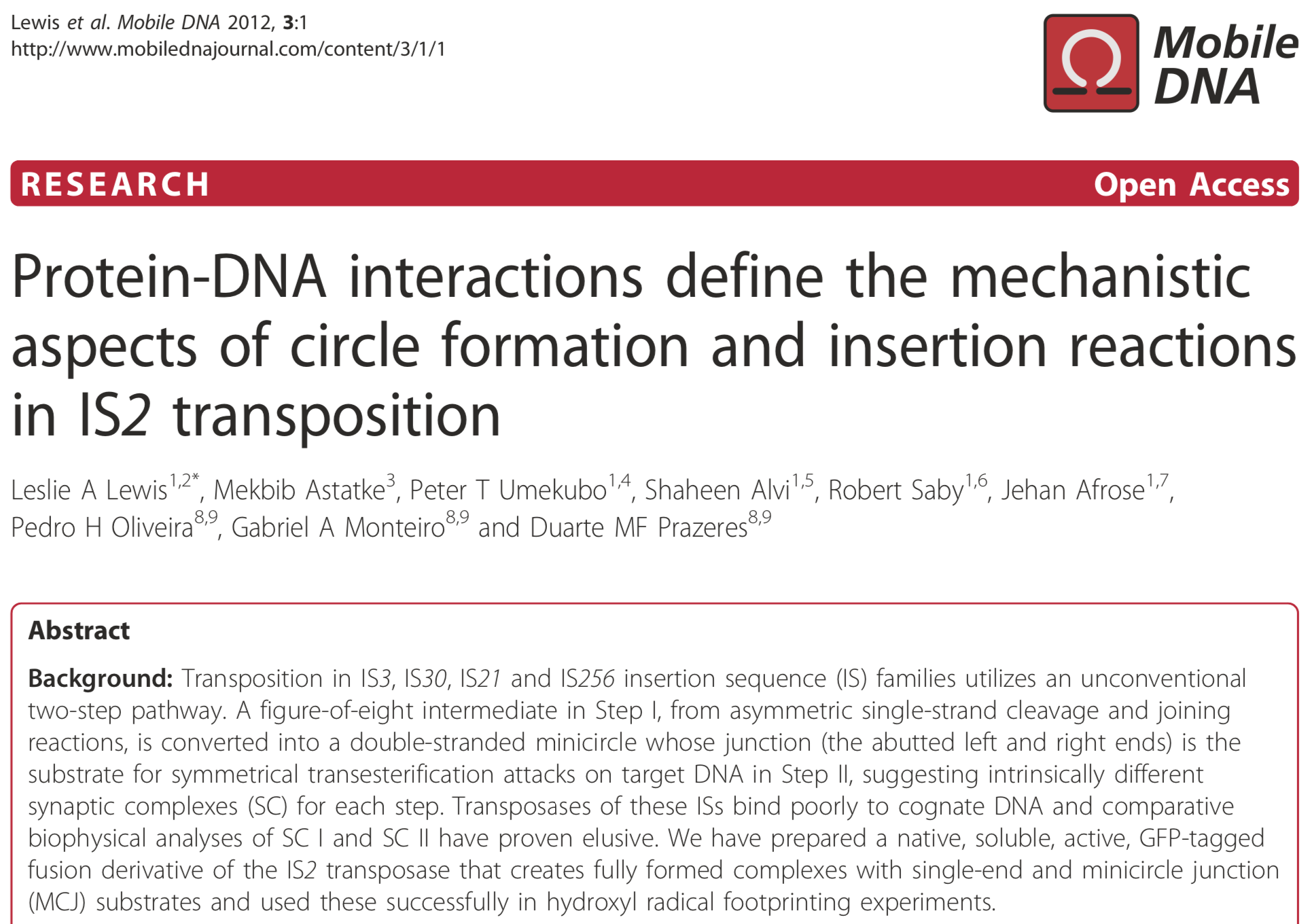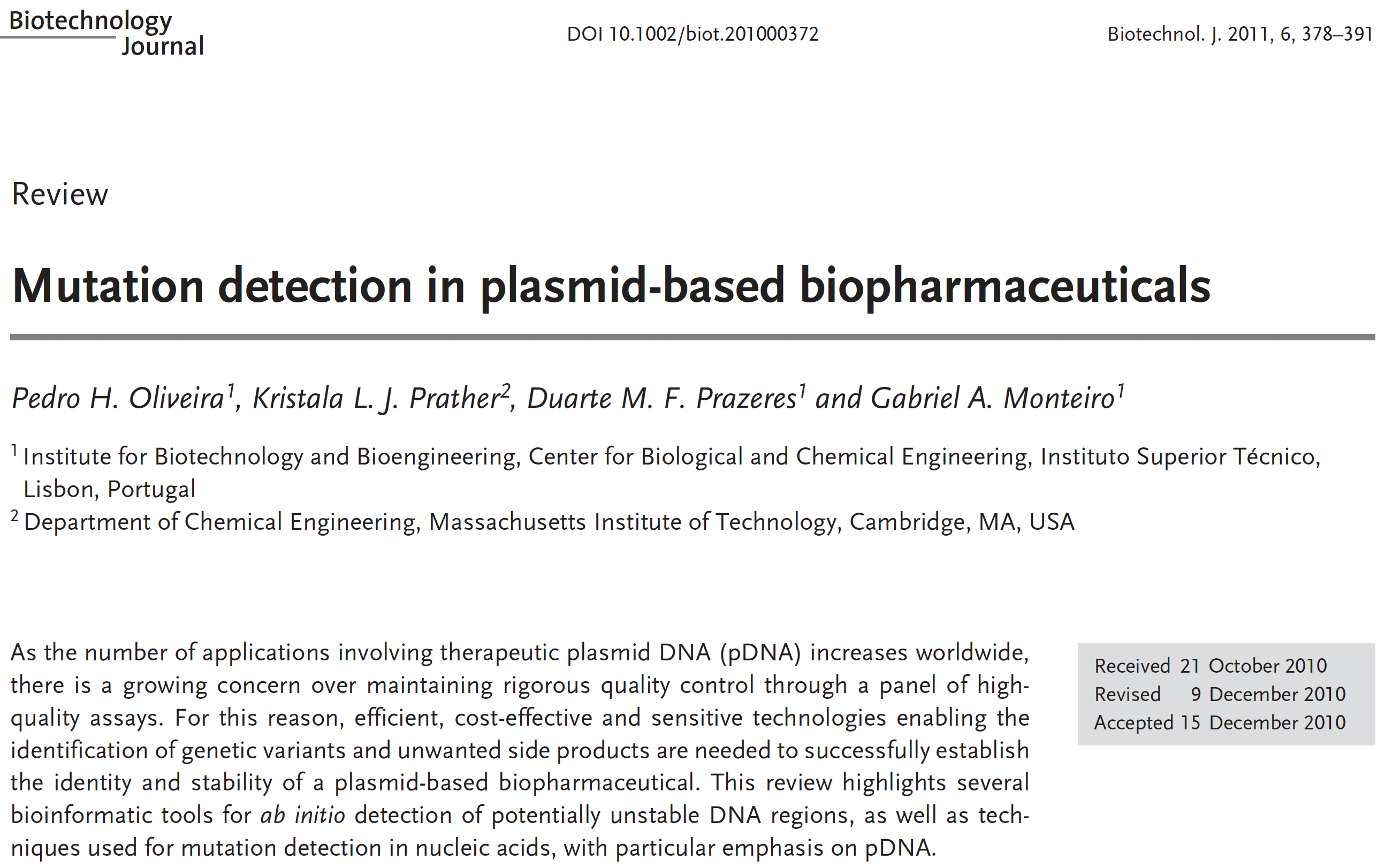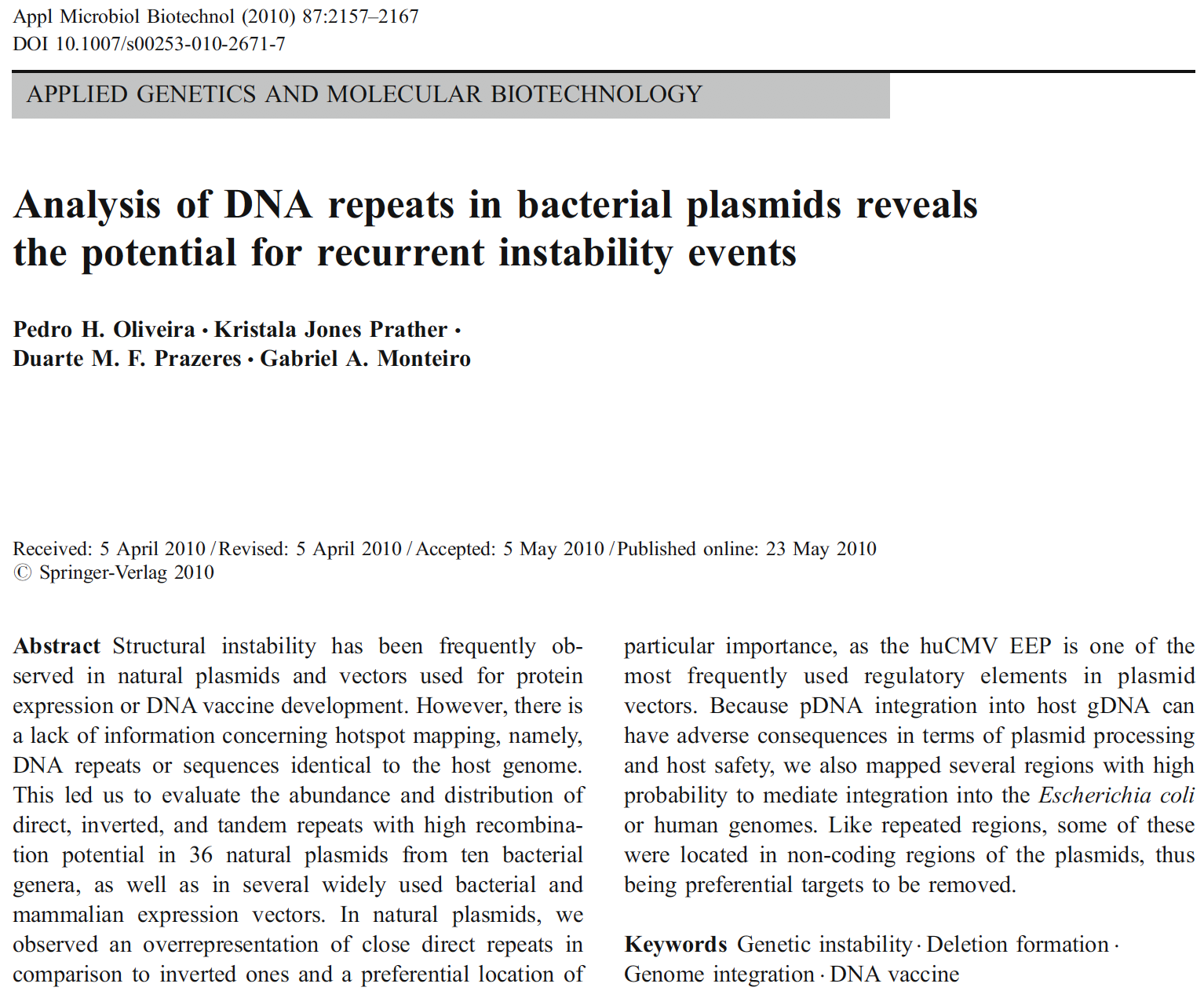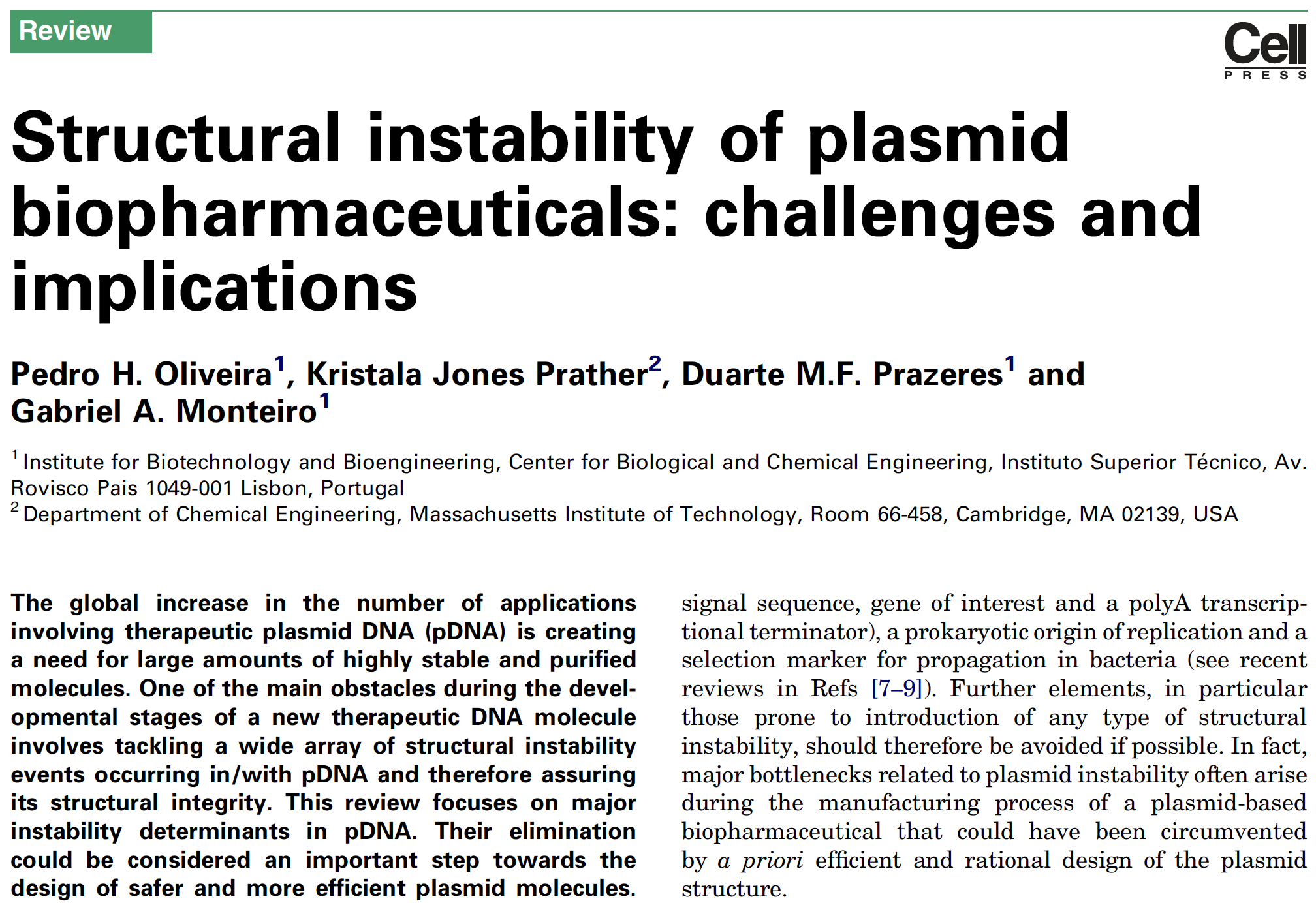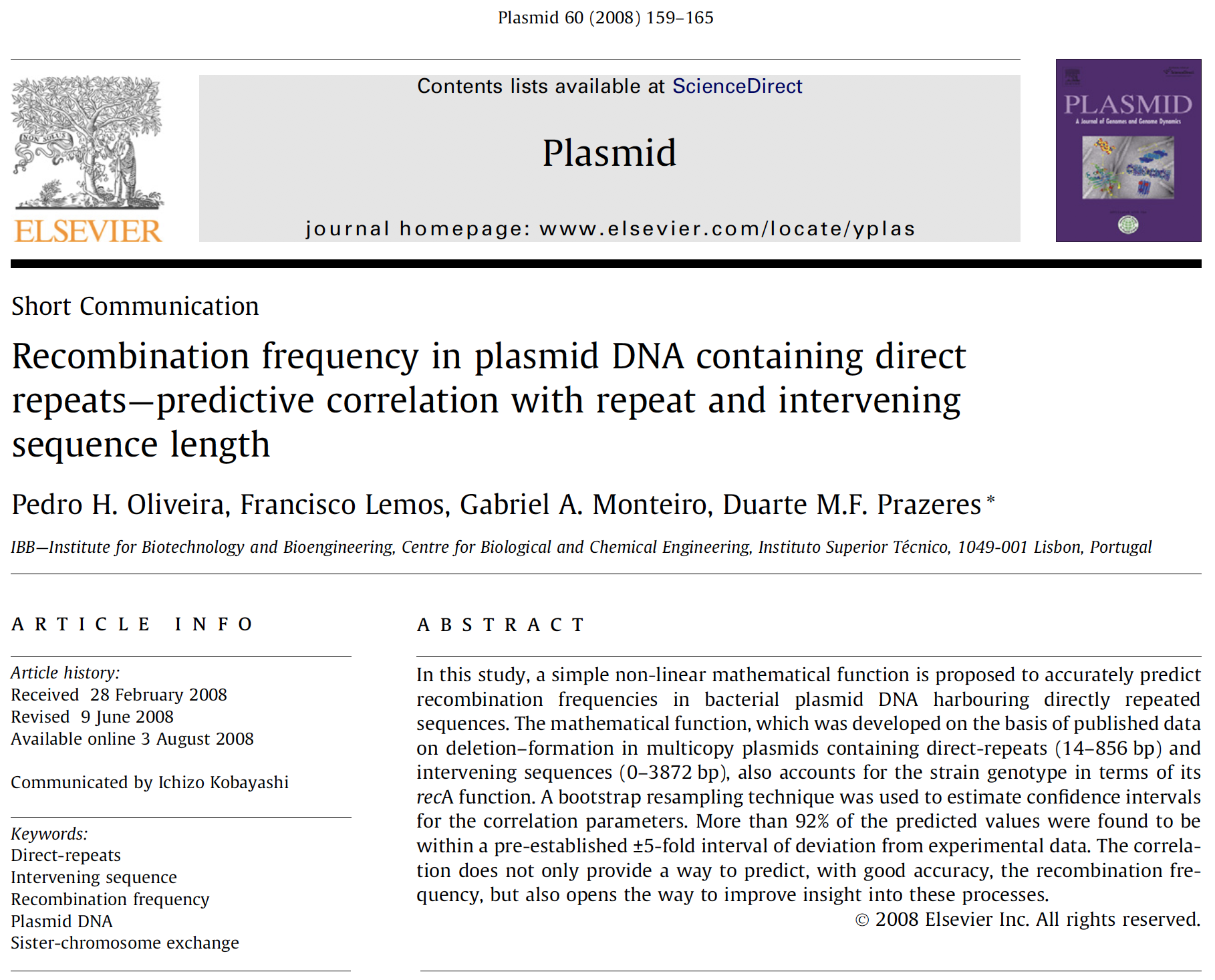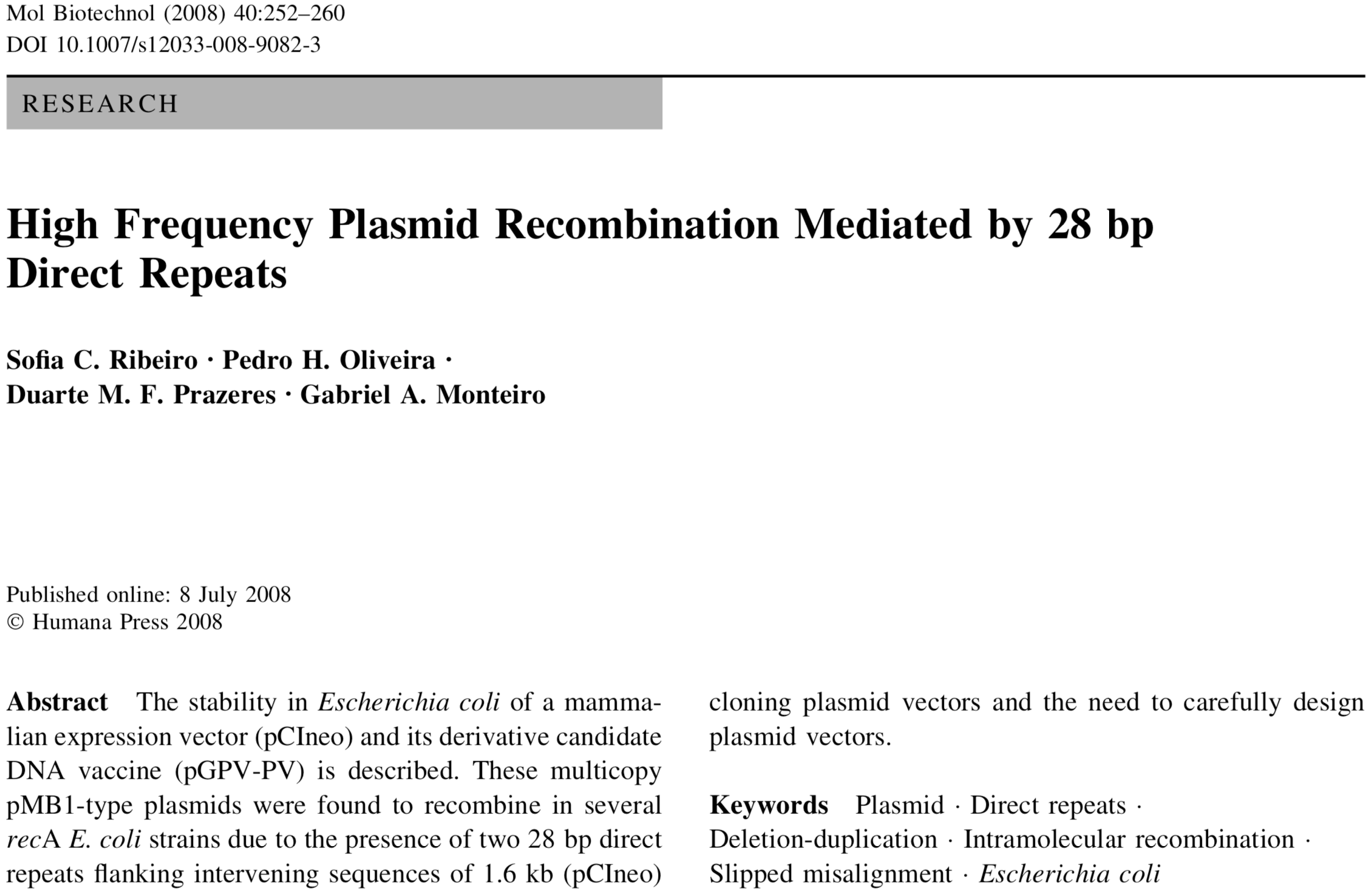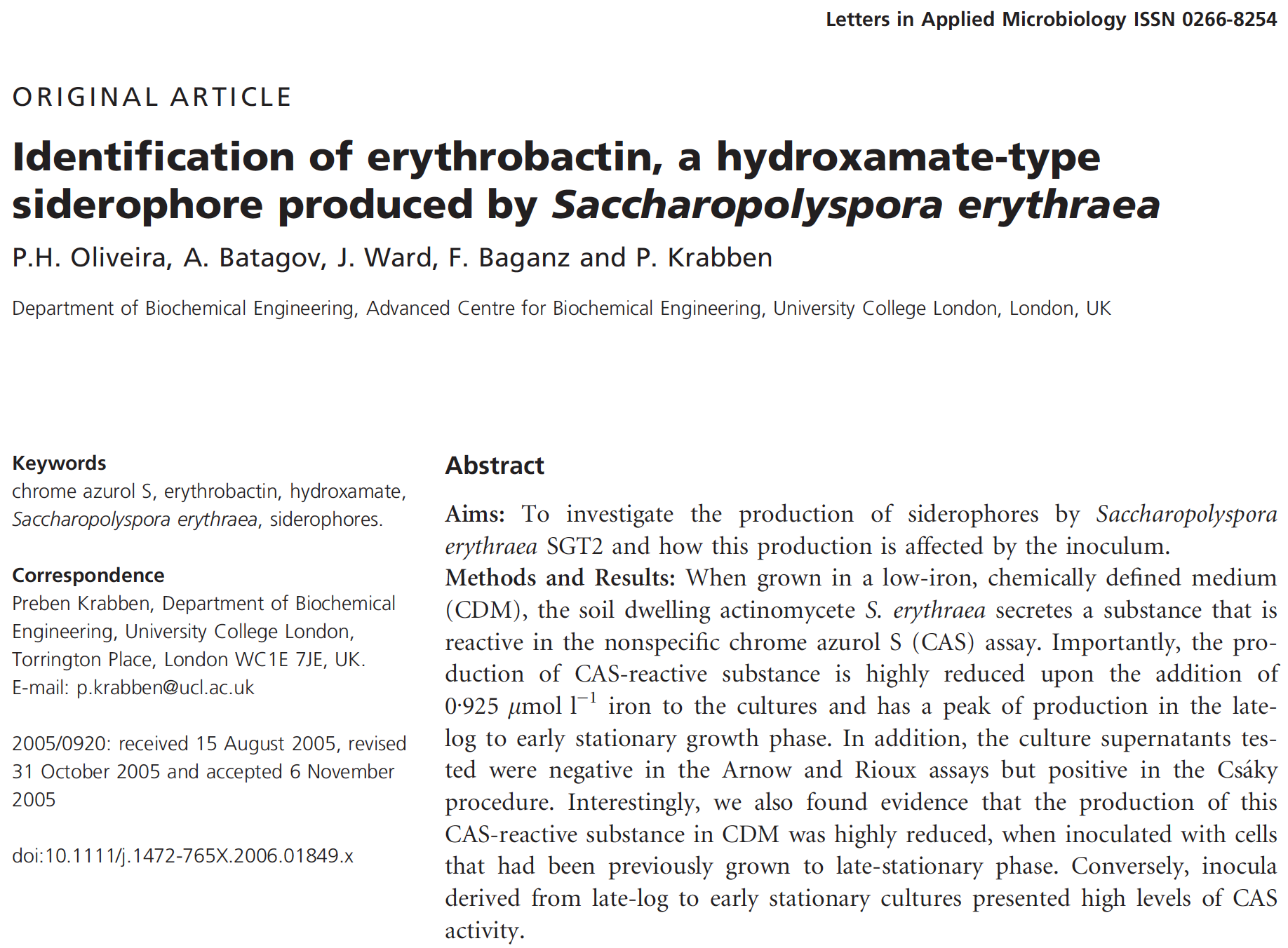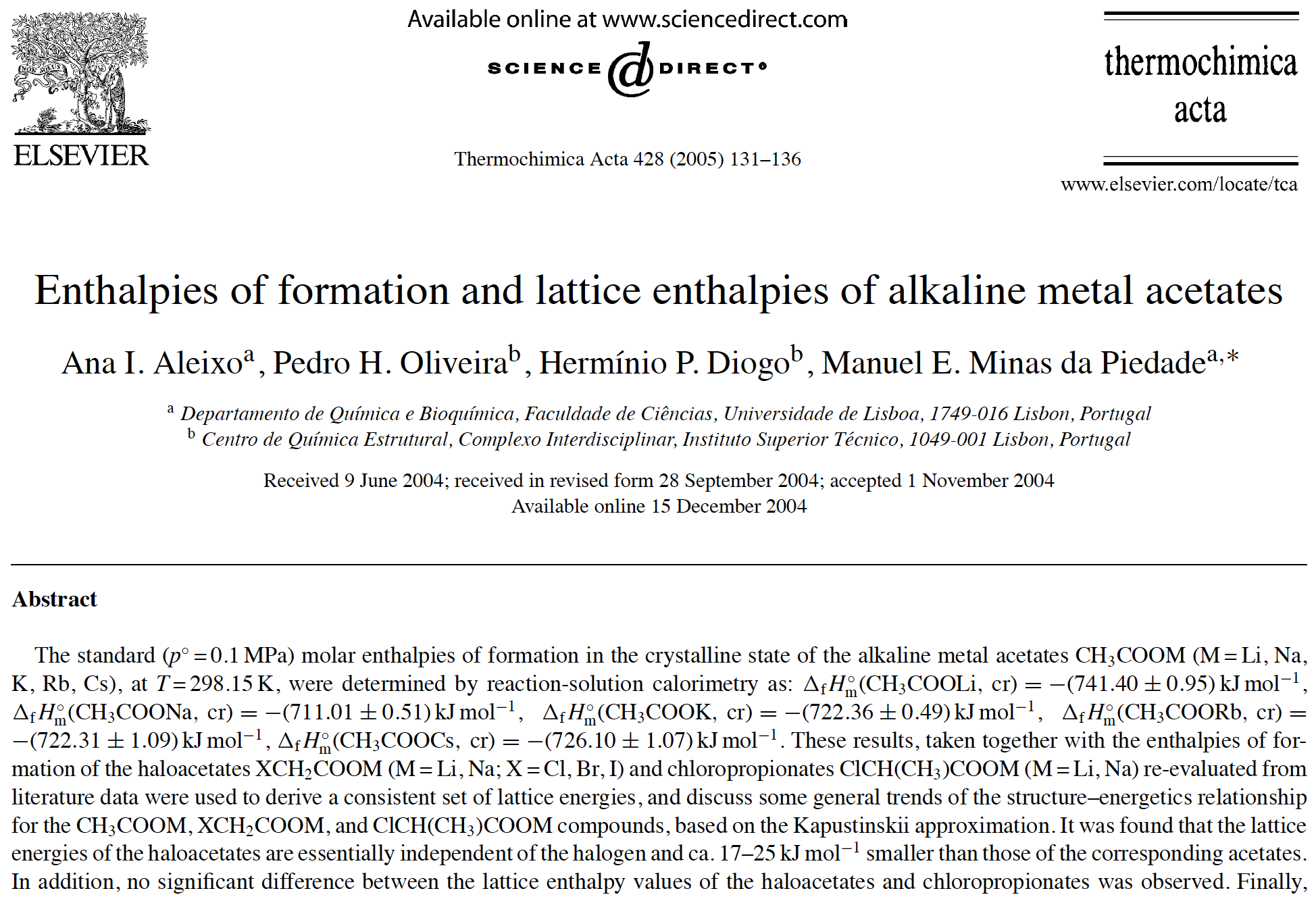Selected publications - Full list here
2024
The defensome of complex bacterial communities
Bacteria have developed various defense mechanisms to avoid infection and killing in response to the fast evolution and turnover of viruses and other genetic parasites. Such pan-immune system (defensome) encompasses a growing number of defense lines that include well-studied innate and adaptive systems such as restriction-modification, CRISPR-Cas and abortive infection, but also newly found ones whose mechanisms are still poorly understood. While the abundance and distribution of defense systems is well-known in complete and culturable genomes, there is a void in our understanding of their diversity and richness in complex microbial communities. Here we performed a large-scale in-depth analysis of the defensomes of 7759 high-quality bacterial population genomes reconstructed from soil, marine, and human gut environments. We observed a wide variation in the frequency and nature of the defensome among large phyla, which correlated with lifestyle, genome size, habitat, and geographic background. The defensome’s genetic mobility, its clustering in defense islands, and genetic variability was found to be system-specific and shaped by the bacterial environment. Hence, our results provide a detailed picture of the multiple immune barriers present in environmentally distinct bacterial communities and set the stage for subsequent identification of novel and ingenious strategies of diversification among uncultivated microbes.
A Beavogui, A Lacroix, N Wiart, J Poulain, TO Delmont, L Paoli, P Wincker & PH Oliveira. (2020). "The defensome of complex bacterial communities". Nature Communications. 15:2146.
2023
Computational epigenomics and epitranscriptomics
Nucleic acids (DNA and RNA) are key repositories of genetic information, and their primary sequence of four canonical nucleobases (A, C, G, T/U) in genomes and transcriptomes defines the genetic blueprints and cellular identities across all branches of life. Moreover, it is recognized that diversity within an organism is often governed by dynamic chemical modifications of nucleobases, which can operate as a regulatory layer to fine-tune key molecular and cellular processes. Changes in epigenomic and epitranscriptomic landscapes can affect a variety of such processes (e.g., transcription, translation, differentiation, and maintenance of genome integrity) and are often linked to the onset and progression of disease. Our understanding of the biochemistry and biological significance of the more than 45 DNA and 170 RNA chemical modifications reported to date has been largely propelled by high-throughput sequencing technologies and mass-spectrometry-based approaches, coupled with chemical, enzymatic, or antibody-dependent methodologies. In parallel, we have witnessed the development of increasingly robust computational methods and statistical tools tailored to make sense of a growing volume of often heterogeneous and noisy epiome data. In this book, the reader is introduced to state-of-the-art computational methods designed to manage, analyze, and generally leverage epigenomic and epitranscriptomic data. Topics include fine-mapping and quantification of modifications, visual analytics, imputation methods, supervised analysis, and integrative approaches for single-cell data. Ultimately this compendium will be of interest to a broad audience including students, biologists, bioinformaticians, and biomedical researchers.
PH Oliveira Eds. (2023). "Computational epigenomics and epitranscriptomics". Methods in Molecular Biology. vol: 2624.
2021
Bacterial Epigenomics: Coming of Age
Epigenetic DNA methylation in bacteria has been traditionally studied in the context of antiparasitic defense and as part of the innate immune discrimination between self and nonself DNA. However, sequencing advances that allow genome-wide analysis of DNA methylation at the single-base resolution are nowadays expanding and have pro- pelled a modern epigenomic revolution in our understanding of the extent, evolution, and physiological relevance of methylation. Indeed, as the number of mapped bacterial methylomes recently surpassed 4,000, increasing evidence supports roles for methylation in gene expression regulation, virulence, and host colonization, among others. In this pa- per, I summarize lessons taken from high-dimensional methylome data analyses and recent efforts that we and others are developing to leverage such findings into meaning- ful biological insights and overarching frameworks. Ultimately, I highlight anticipated research avenues and technological developments likely to unfold in the coming years.
Conserved DNA methyltransferases: A window into fundamental mechanisms of epigenetic regulation in Bacteria
An increasing number of studies have reported that bacterial DNA methylation has important functions beyond the roles in restriction-modification systems, including the ability of affecting clinically relevant phenotypes such as virulence, host colonization, sporulation, biofilm formation, among others. Although insightful, such studies have a largely ad hoc nature and would benefit from a systematic strategy enabling a joint functional characterization of bacterial methylomes by the microbiology community. In this opinion article, we propose that highly conserved DNA methyltransferases (MTases) represent a unique opportunity for bacterial epigenomic studies. These MTases are rather common in bacteria, span various taxonomic scales, and are present in multiple human pathogens. Apart from well-characterized core DNA MTases, like those from Vibrio cholerae, Salmonella enterica, Clostridioides difficile, or Streptococcus pyogenes, multiple highly conserved DNA MTases are also found in numerous human pathogens, including those belonging to the genera Burkholderia and Acinetobacter. We discuss why and how these MTases can be prioritized to enable a community-wide, integrative approach for functional epigenomic studies. Ultimately, we discuss how some highly conserved DNA MTases may emerge as promising targets for the development of novel epigenetic inhibitors for biomedical applications.
PH Oliveira & G Fang. (2021). "Conserved DNA methyltransferases: A window into fundamental mechanisms of epigenetic regulation in Bacteria". Trends in Microbiology. 29(1):28-40.
2020
Epigenomic characterization of Clostridioides difficile finds a conserved DNA methyltransferase that mediates sporulation and pathogenesis
Clostridioides (formerly Clostridium) difficile is a leading cause of healthcare-associated infections. Although considerable progress has been made in the understanding of its genome, the epigenome of C. difficile and its functional impact has not been systematically explored. Here, we perform a comprehensive DNA methylome analysis of C. difficile using 36 human isolates and observe a high level of epigenomic diversity. We discovered an orphan DNA methyltransferase with a well-defined specificity, the corresponding gene of which is highly conserved across our dataset and in all of the approximately 300 global C. difficile genomes examined. Inactivation of the methyltransferase gene negatively impacts sporulation, a key step in C. difficile disease transmission, and these results are consistently supported by multiomics data, genetic experiments and a mouse colonization model. Further experimental and transcriptomic analyses suggest that epigenetic regulation is associated with cell length, biofilm formation and host colonization. These findings provide a unique epigenetic dimension to characterize medically relevant biological processes in this important pathogen. This study also provides a set of methods for comparative epigenomics and integrative analysis, which we expect to be broadly applicable to bacterial epigenomic studies.
PH Oliveira, JW Ribis, EM Garrett, D Trzilova, A Kim, O Sekulovic, EA Mead, T Pak, S Zhu, G Deikus, M Touchon, M Lewis-Sandari, C Beckford, NE Zeitouni, DR Altman, E Webster, I Oussenko, S Bunyavanich, AK Aggarwal, A Bashir, G Patel, F Wallach, C Hamula, S Huprikar, EE Schadt, R Sebra, H van Bakel, A Kasarskis, R Tamayo, A Shen & G Fang. (2020). "Epigenomic characterization of Clostridioides difficile finds a conserved DNA methyltransferase that mediates sporulation and pathogenesis". Nature Microbiology. 5 (1): 166-180.
2018
Host range and genetic plasticity explain the coexistence of integrative and extrachromosomal mobile genetic elements
Self-transmissible mobile genetic elements drive horizontal gene transfer between prokaryotes. Some of these elements integrate in the chromosome, whereas others replicate autonomously as plasmids. Recent works showed the existence of few differences, and occasional interconversion, between the two types of elements. Here, we enquired on why evolutionary processes have maintained the two types of mobile genetic elements by comparing integrative and conjugative elements (ICE) with extrachromosomal ones (conjugative plasmids) of the highly abundant MPFT conjugative type. We observed that plasmids encode more replicases, partition systems, and antibiotic resistance genes, whereas ICEs encode more integrases and metabolism-associated genes. ICEs and plasmids have similar average sizes, but plasmids are much more variable, have more DNA repeats, and exchange genes more frequently. On the other hand, we found that ICEs are more frequently transferred between distant taxa. We propose a model where the different genetic plasticity and amplitude of host range between elements explain the co-occurrence of integrative and extrachromosomal elements in microbial populations. In particular, the conversion from ICE to plasmid allows ICE to be more plastic, while the conversion from plasmid to ICE allows the expansion of the element’s host range.
J Cury, PH Oliveira, F de la Cruz & EPC Rocha. (2018). "Host range and genetic plasticity explain the coexistence of integrative and extrachromosomal mobile genetic elements". Molecular Biology and Evolution . 35 (9): 2230–2239.
2017
The chromosomal organization of gene transfer in bacteria
Bacterial adaptation is accelerated by the acquisition of novel traits through horizontal gene transfer, but the integration of these genes affects genome organization. We found that transferred genes are concentrated in only ~1% of the chromosomal regions (hotspots) in 80 bacterial species. This concentration increases with genome size and with the rate of transfer. Hotspots diversify by rapid gene turnover; their chromosomal distribution depends on local contexts (neighboring core genes), and content in mobile genetic elements. Hotspots concentrate most changes in gene repertoires, reduce the trade-off between genome diversification and organization, and should be treasure troves of strain-specific adaptive genes. Most mobile genetic elements and antibiotic resistance genes are in hotspots, but many hotspots lack recognizable mobile genetic elements and exhibit frequent homologous recombination at flanking core genes. Overrepresentation of hotspots with fewer mobile genetic elements in naturally transformable bacteria suggests that homologous recombination and horizontal gene transfer are tightly linked in genome evolution.Horizontal gene transfer (HGT) is an important mechanism for genome evolution and adaptation in bacteria. Here, Oliveira and colleagues find HGT hotspots comprising ~ 1% of the chromosomal regions in 80 bacterial species.
PH Oliveira, M Touchon, J Cury & EPC Rocha. (2017). "The chromosomal organization of gene transfer in bacteria". Nature Communications. 8 (1): 841.
2016
Regulation of genetic flux between bacteria by restriction-modification systems
Restriction-modification (R-M) systems are often regarded as bacteria's innate immune systems, protecting cells from infection by mobile genetic elements (MGEs). Their diversification has been recently associated with the emergence of particularly virulent lineages. However, we have previously found more R-M systems in genomes carrying more MGEs. Furthermore, it has been suggested that R-M systems might favor genetic transfer by producing recombinogenic double-stranded DNA ends. To test whether R-M systems favor or disfavor genetic exchanges, we analyzed their frequency with respect to the inferred events of homologous recombination and horizontal gene transfer within 79 bacterial species. Genetic exchanges were more frequent in bacteria with larger genomes and in those encoding more R-M systems. We created a recognition target motif predictor for Type II R-M systems that identifies genomes encoding systems with similar restriction sites. We found more genetic exchanges between these genomes, independently of their evolutionary distance. Our results reconcile previous studies by showing that R-M systems are more abundant in promiscuous species, wherein they establish preferential paths of genetic exchange within and between lineages with cognate R-M systems. Because the repertoire and/or specificity of R-M systems in bacterial lineages vary quickly, the preferential fluxes of genetic transfer within species are expected to constantly change, producing time-dependent networks of gene transfer.
PH Oliveira, M Touchon & EPC Rocha. (2016). "Regulation of genetic flux between bacteria by restriction-modification systems". PNAS. 113 (20): 5658–5663.
2014
The interplay of restriction modification systems with mobile genetic elements and their prokaryotic hosts
The roles of restriction-modification (R-M) systems in providing immunity against horizontal gene transfer (HGT) and in stabilizing mobile genetic elements (MGEs) have been much debated. However, few studies have precisely addressed the distribution of these systems in light of HGT, its mechanisms and its vectors. We analyzed the distribution of R-M systems in 2261 prokaryote genomes and found their frequency to be strongly dependent on the presence of MGEs, CRISPR-Cas systems, integrons and natural transformation. Yet R-M systems are rare in plasmids, in prophages and nearly absent from other phages. Their abundance depends on genome size for small genomes where it relates with HGT but saturates at two occurrences per genome. Chromosomal R-M systems might evolve under cycles of purifying and relaxed selection, where sequence conservation depends on the biochemical activity and complexity of the system and total gene loss is frequent. Surprisingly, analysis of 43 pan-genomes suggests that solitary R-M genes rarely arise from the degradation of R-M systems. Solitary genes are transferred by large MGEs, whereas complete systems are more frequently transferred autonomously or in small MGEs. Our results suggest means of testing the roles for R-M systems and their associations with MGEs.
PH Oliveira, M Touchon & EPC Rocha. (2014). "The interplay of restriction-modification systems with mobile genetic elements and their prokaryotic hosts". Nucleic Acids Research. 42 (16): 10618–10631.
Genomic instability in human stem cells : current status and future challenges
Genomic instability is recognized as one of the most important hurdles in the expanding field of stem cell-based therapies. In the recent years, an accumulating body of evidence has shown that human stem cells undergo a diverse program of biological changes upon ex vivo cultivation that include numerical and structural chromosomal abnormalities, point mutations, variation of telomere length, and epigenetic instability. As the field moves forward, the growing awareness of the risk factors associated with human genome plasticity strongly advocates for the use of extensive genetic screening as part of a quality control platform to attest to the safety of stem cell-based products. Here we present a timely and comprehensive review that addresses the current status and emerging trends of the field, ultimately underscoring the need to implement new regulatory standards able to streamline the route to therapeutic applications.
PH Oliveira, CL da Silva & JMS Cabral. (2014). "Genomic instability in human stem cells : current status and future challenges". Stem Cells. 32 (11): 2824–2832.
Evidence that the insertion events of IS2 transposition are biased towards abrupt compositional shifts in target DNA and modulated by a diverse set of culture parameters
Insertion specificity of mobile genetic elements is a rather complex aspect of DNA transposition, which, despite much progress towards its elucidation, still remains incompletely understood. We report here the results of a meta-analysis of IS2 target sites from genomic, phage, and plasmid DNA and find that newly acquired IS2 elements are consistently inserted around abrupt DNA compositional shifts, particularly in the form of switch sites of GC skew. The results presented in this study not only corroborate our previous observations that both the insertion sequence (IS) minicircle junction and target region adopt intrinsically bent conformations in IS2, but most interestingly, extend this requirement to other families of IS elements. Using this information, we were able to pinpoint regions with high propensity for transposition and to predict and detect, de novo, a novel IS2 insertion event in the 3' region of the gfp gene of a reporter plasmid. We also found that during amplification of this plasmid, process parameters such as scale, culture growth phase, and medium composition exacerbate IS2 transposition, leading to contamination levels with potentially detrimental clinical effects. Overall, our findings provide new insights into the role of target DNA structure in the mechanism of transposition of IS elements and extend our understanding of how culture conditions are a relevant factor in the induction of genetic instability.
GAL Gonçalves, PH Oliveira, AG Gomes, KLJ Prather, LA Lewis, DMF Prazeres & GA Monteiro. (2014). "Evidence that the insertion events of IS2 transposition are biased towards abrupt compositional shifts in target DNA and modulated by a diverse set of culture parameters". Applied Microbiology and Biotechnology. 98 (15): 6609–6619.
DNA instability in bacterial genomes: causes and consequences
DNA is a structurally dynamic molecule that is central to cellular processes such as replication, transcription and recombination. In order to maintain genomic integrity, bacteria have developed a finely tuned and interwoven network of mechanisms that operate at multiple levels, and include damage recognition, signaling pathways, and DNA repair. On the other hand, without the capacity to accommodate genotypic variation up to a certain extent, bacteria would not be able to modify their fitness when faced with constantly changing environments. Herein we review our current knowledge on bacterial genome instability, with particular emphasis on findings gained from the often-studied gram-negative model organism Escherichia coli. We will address topics such as spontaneous and stress-induced mutagenesis, major DNA repair pathways, and the design of more stable genomes. Major questions and future challenges will also be discussed.
PH Oliveira, DMF Prazeres & GA Monteiro. (2014). "DNA instability in bacterial genomes: causes and consequences". In: Genome Analysis: Current Procedures and Applications. Caister Academic Press.
2013
Marker-free plasmids for biotechnological applications – implications and perspectives
Nonviral gene therapy and DNA vaccines have become the first promising approaches to treat, cure, or ultimately prevent disease by providing genetic information encoded on a plasmid. Since 1989, more than 1800 clinical trials have been approved worldwide, and approximately 20% of them are using plasmid DNA (pDNA) as a vector system. Although much safer than viral approaches, DNA vectors generally do encode antibiotic resistance genes in the plasmid backbone. These antibiotic resistance markers constitute a possible safety risk, and they are associated with structural plasmid instabilities and decreased gene delivery efficiency. These drawbacks have initiated the development of various antibiotic marker-free selection approaches. We provide an overview on the potential implications of marker-free plasmids and perspectives for their successful biotechnological use in the future.
PH Oliveira & J Mairhofer. (2013). "Marker-free plasmids for biotechnological applications – implications and perspectives". Trends in Biotechnology. 31 (9): 539–547.
An appraisal of human mitochondrial DNA instability : new insights into the role of non-canonical DNA structures and sequence motifs
Mitochondrial DNA (mtDNA) deletion mutations are frequently observed in aged postmitotic tissues and are the cause of a wide range of human disorders. Presently, the molecular bases underlying mtDNA deletion formation remain a matter of intense debate, and it is commonly accepted that several mechanisms contribute to the spectra of mutations in the mitochondrial genome. In this work we performed an extensive screening of human mtDNA deletions and evaluated the association between breakpoint density and presence of non-canonical DNA elements and over-represented sequence motifs. Our observations support the involvement of helix-distorting intrinsically curved regions and long G-tetrads in eliciting instability events. In addition, higher breakpoint densities were consistently observed within GC-skewed regions and in the close vicinity of the degenerate sequence motif YMMYMNNMMHM. A parallelism is also established with hot spot motifs previously identified in the nuclear genome, as well as with the minimal binding site for the mitochondrial transcription termination factor mTERF. This study extends the current knowledge on the mechanisms driving mitochondrial rearrangements and opens up exciting avenues for further research.
PH Oliveira, CL da Silva & JMS Cabral. (2013). "An appraisal of human mitochondrial DNA instability : new insights into the role of non-canonical DNA structures and sequence motifs". PLoS ONE. 8 (3): e59907.
2012
Impact of hypoxia and long-term cultivation on the genomic stability and mitochondrial performance of ex-vivo expanded human stem/stromal cells
Recent studies have described the occurrence of chromosomal abnormalities and mitochondrial dysfunction in human stem/stromal cells (SCs), particularly after extensive passaging in vitro and/or expansion under low oxygen tensions. To deepen this knowledge we investigated the influence of hypoxia (2% O(2)) and prolonged passaging (>P10) of human bone marrow stromal cells (BMSCs) and adipose-derived stromal cells (ASCs) on the expression of genes involved in DNA repair and cell-cycle regulation pathways, as well as on the occurrence of microsatellite instability and changes in telomere length. Our results show that hypoxic conditions induce an immediate and concerted down-regulation of genes involved in DNA repair and damage response pathways (MLH1, RAD51, BRCA1, and Ku80), concomitantly with the occurrence of microsatellite instability while maintaining telomere length. We further searched for mutations occurring in the mitochondrial genome, and monitored changes in intracellular ATP content, membrane potential and mitochondrial DNA content. Hypoxia led to a simultaneous decrease in ATP content and in the number of mitochondrial genomes, whereas the opposite effect was observed after prolonged passaging. Moreover, we show that neither hypoxia nor prolonged passaging significantly affected the integrity of the mitochondrial genome. Ultimately, we present evidence on how hypoxia selectively impacts the cellular response of BMSCs and ASCs, thus pointing for the need to optimize oxygen tension according to the cell source.
PH Oliveira, JS Boura, MM Abecasis, JM Gimble, CL da Silva & JMS Cabral. (2012). "Impact of hypoxia and long-term cultivation on the genomic stability and mitochondrial performance of ex-vivo expanded human stem/stromal cells". Stem Cell Research. 9 (3): 225-236.
Fishing human monoclonal antibodies from a CHO cell supernatant with boronic acid magnetic particles
In this work we have evaluated the potential of boronic acid functionalized magnetic particles for the one-step capture of a human monoclonal antibody (mAb) from a Chinese hamster ovary (CHO) cell culture supernatant. For comparison, Protein A coated magnetic particles were also used. The most important factor influencing the overall process yield and product purity in boronic acid particles was found to be the binding pH. Basic pH values promoted higher purities while resulting in decreased yields due to the competing effects of molecules such as glucose and lactate present in the cell culture supernatant. After optimization, the particles were successfully used in a multi-cycle purification process of the mAb from the CHO feedstock. Boronic acid particles were able to achieve an average overall yield of 86% with 88% removal of CHO host cell proteins (HCP) when the binding was performed at pH 7.4, while at pH 8.5 these values were 58% and 97%, respectively. In both cases, genomic DNA removal was in excess of 97%. Comparatively, Protein A particles recorded an average overall yield of 80% and an HCP removal greater than 99%. The adsorption of the mAb to the boronic acid particles was shown to be mediated by strong affinity interactions. Overall, boronic acid based purification processes can offer a cost-effective alternative to Protein A as the direct capturing step from the mammalian cell culture.
L Borlido, AM Azevedo, AG Sousa, PH Oliveira, AC Roque & MR Aires-Barros. (2012). "Fishing human monoclonal antibodies from a CHO cell supernatant with boronic acid magnetic particles". Journal of Chromatography B. 903: 163-170.
Protein-DNA interactions define the mechanistic aspects of circle formation and insertion reactions in IS2 transposition
BACKGROUND: Transposition in IS3, IS30, IS21 and IS256 insertion sequence (IS) families utilizes an unconventional two-step pathway. A figure-of-eight intermediate in Step I, from asymmetric single-strand cleavage and joining reactions, is converted into a double-stranded minicircle whose junction (the abutted left and right ends) is the substrate for symmetrical transesterification attacks on target DNA in Step II, suggesting intrinsically different synaptic complexes (SC) for each step. Transposases of these ISs bind poorly to cognate DNA and comparative biophysical analyses of SC I and SC II have proven elusive. We have prepared a native, soluble, active, GFP-tagged fusion derivative of the IS2 transposase that creates fully formed complexes with single-end and minicircle junction (MCJ) substrates and used these successfully in hydroxyl radical footprinting experiments. RESULTS: In IS2, Step I reactions are physically and chemically asymmetric; the left imperfect, inverted repeat (IRL), the exclusive recipient end, lacks donor function. In SC I, different protection patterns of the cleavage domains (CDs) of the right imperfect inverted repeat (IRR; extensive in cis) and IRL (selective in trans) at the single active cognate IRR catalytic center (CC) are related to their donor and recipient functions. In SC II, extensive binding of the IRL CD in trans and of the abutted IRR CD in cis at this CC represents the first phase of the complex. An MCJ substrate precleaved at the 3' end of IRR revealed a temporary transition state with the IRL CD disengaged from the protein. We propose that in SC II, sequential 3' cleavages at the bound abutted CDs trigger a conformational change, allowing the IRL CD to complex to its cognate CC, producing the second phase. Corroborating data from enhanced residues and curvature propensity plots suggest that CD to CD interactions in SC I and SC II require IRL to assume a bent structure, to facilitate binding in trans. CONCLUSIONS: Different transpososomes are assembled in each step of the IS2 transposition pathway. Recipient versus donor end functions of the IRL CD in SC I and SC II and the conformational change in SC II that produces the phase needed for symmetrical IRL and IRR donor attacks on target DNA highlight the differences.
LA Lewis, M Astatke, PT Umekubo, S Alvi, PT Umekubo, S Alvi, R Saby, J Afrose, PH Oliveira, GA Monteiro & DMF Prazeres. (2012). "Protein-DNA interactions define the mechanistic aspects of circle formation and insertion reactions in IS2 transposition". Mobile DNA. 3: 1.
2011
Mutation detection in plasmid-based biopharmaceuticals
As the number of applications involving therapeutic plasmid DNA (pDNA) increases worldwide, there is a growing concern over maintaining rigorous quality control through a panel of high-quality assays. For this reason, efficient, cost-effective and sensitive technologies enabling the identification of genetic variants and unwanted side products are needed to successfully establish the identity and stability of a plasmid-based biopharmaceutical. This review highlights several bioinformatic tools for ab initio detection of potentially unstable DNA regions, as well as techniques used for mutation detection in nucleic acids, with particular emphasis on pDNA.
PH Oliveira, KL Prather, DMF Prazeres & GA Monteiro. (2011). "Mutation detection in plasmid-based biopharmaceuticals". Biotechnology Journal. 6: 378-391.
2010
Analysis of DNA repeats in bacterial plasmids reveals the potential for recurrent instability events
Structural instability has been frequently observed in natural plasmids and vectors used for protein expression or DNA vaccine development. However, there is a lack of information concerning hotspot mapping, namely, DNA repeats or sequences identical to the host genome. This led us to evaluate the abundance and distribution of direct, inverted, and tandem repeats with high recombination potential in 36 natural plasmids from ten bacterial genera, as well as in several widely used bacterial and mammalian expression vectors. In natural plasmids, we observed an overrepresentation of close direct repeats in comparison to inverted ones and a preferential location of repeats with high recombination potential in intergenic regions, suggesting a highly plastic and dynamic behavior. In plasmid vectors, we found a high density of repeats within eukaryotic promoters and non-coding sequences. As a result of this in silico analysis, we detected a spontaneous recombination between two 21-bp direct repeats present in the human cytomegalovirus early enhancer/promoter (huCMV EEP) of the pCIneo plasmid. This finding is of particular importance, as the huCMV EEP is one of the most frequently used regulatory elements in plasmid vectors. Because pDNA integration into host gDNA can have adverse consequences in terms of plasmid processing and host safety, we also mapped several regions with high probability to mediate integration into the Escherichia coli or human genomes. Like repeated regions, some of these were located in non-coding regions of the plasmids, thus being preferential targets to be removed.
PH Oliveira, KL Prather, DMF Prazeres & GA Monteiro. (2010). "Analysis of DNA repeats in bacterial plasmids reveals the potential for recurrent instability events". Applied Microbiology and Biotechnology. 87: 2157-2167.
2009
Structural instability of plasmid biopharmaceuticals: challenges and implications
The global increase in the number of applications involving therapeutic plasmid DNA (pDNA) is creating a need for large amounts of highly stable and purified molecules. One of the main obstacles during the developmental stages of a new therapeutic DNA molecule involves tackling a wide array of structural instability events occurring in/with pDNA and therefore assuring its structural integrity. This review focuses on major instability determinants in pDNA. Their elimination could be considered an important step towards the design of safer and more efficient plasmid molecules. Particular emphasis is given to mutations triggered by the presence of repeated sequences, instability events occurring during plasmid intracellular routing, instability mediated by insertion sequences and host genome integration.
PH Oliveira, KL Prather, DMF Prazeres & GA Monteiro. (2010). "Structural instability of plasmid biopharmaceuticals: challenges and implications". Trends in Biotechnology. 27: 503-511.
2008
Recombination frequency in plasmid DNA containing direct repeats – predictive correlation with repeat and intervening sequence length
In this study, a simple non-linear mathematical function is proposed to accurately predict recombination frequencies in bacterial plasmid DNA harbouring directly repeated sequences. The mathematical function, which was developed on the basis of published data on deletion–formation in multicopy plasmids containing direct-repeats (14–856 bp) and intervening sequences (0–3872 bp), also accounts for the strain genotype in terms of its recA function. A bootstrap resampling technique was used to estimate confidence intervals for the correlation parameters. More than 92% of the predicted values were found to be within a pre-established ±5-fold interval of deviation from experimental data. The correlation does not only provide a way to predict, with good accuracy, the recombination frequency, but also opens the way to improve insight into these processes.
PH Oliveira, F Lemos, GA Monteiro & DMF Prazeres. (2008). "Recombination frequency in plasmid DNA containing direct repeats – predictive correlation with repeat and intervening sequence length". Plasmid. 60: 159-165.
High frequency plasmid recombination mediated by 28 bp direct repeats
The stability in Escherichia coli of a mammalian expression vector (pCIneo) and its derivative candidate DNA vaccine (pGPV-PV) is described. These multicopy pMB1-type plasmids were found to recombine in several recA E. coli strains due to the presence of two 28 bp direct repeats flanking intervening sequences of 1.6 kb (pCIneo) and 3.2 kb (pGPV-PV). In this recombination event, one of the direct repeats and the intervening sequence were deleted or duplicated, originating monomeric or/and hetero-dimeric plasmid forms, respectively. Additionally, the plasmid rearrangement led to the acquisition of a kanamycin resistance phenotype. Recombination frequencies between 7.8 x 10(-7) and 3.1 x 10(-5) were determined for DH5alpha and JM109(DE3) strains, respectively. Higher recombination frequencies were found in cells previously grown up to stationary growth phase being the monomeric plasmid form the prevalent one. Real-time PCR quantification revealed the presence of approximately 1.5 x 10(4) recombined molecules per 2 x 10(5 )cells pre-kanamycin exposure. Under selective pressure of this antibiotic, the number of recombined molecules increased approximately 2,000-fold in a 48-h period replacing the original plasmid form. The high frequency, at which deletion-duplication occurred in the absence of kanamycin selective pressure, should be regarded as a safety concern. This work highlights the impact of mutational hot spots on expression and cloning plasmid vectors and the need to carefully design plasmid vectors.
SC Ribeiro, PH Oliveira, DMF Prazeres & GA Monteiro. (2008). "High frequency plasmid recombination mediated by 28 bp direct repeats". Molecular Biotechnology. 40: 252-260.
2006
Identification of Erythrobactin, a hydroxamate-type siderophore produced by Saccharopolyspora erythraea
AIMS: To investigate the production of siderophores by Saccharopolyspora erythraea SGT2 and how this production is affected by the inoculum. METHODS AND RESULTS: When grown in a low-iron, chemically defined medium (CDM), the soil dwelling actinomycete S. erythraea secretes a substance that is reactive in the nonspecific chrome azurol S (CAS) assay. Importantly, the production of CAS-reactive substance is highly reduced upon the addition of 0.925 micromol l(-1) iron to the cultures and has a peak of production in the late-log to early stationary growth phase. In addition, the culture supernatants tested were negative in the Arnow and Rioux assays but positive in the Csáky procedure. Interestingly, we also found evidence that the production of this CAS-reactive substance in CDM was highly reduced, when inoculated with cells that had been previously grown to late-stationary phase. Conversely, inocula derived from late-log to early stationary cultures presented high levels of CAS activity. CONCLUSIONS: These results indicate that S. erythraea produces a hydroxamate-type siderophore that we have generically designated as erythrobactin. Additionally, the inocula growth stage plays a key role in siderophore production in S. erythraea. SIGNIFICANCE AND IMPACT OF THE STUDY: It is the first evidence for siderophore synthesis in S. erythraea and one of the first examples of non-polyketide secondary metabolite production by this organism.
PH Oliveira, A Batagov, J Ward, F Baganz & P Krabben. (2006). "Identification of Erythrobactin, a hydroxamate-type siderophore produced by Saccharopolyspora erythraea". Letters in Applied Microbiology. 42: 375-380.
2005
Enthalpies of formation and lattice enthalpies of alkaline metal acetates
The standard (p° = 0.1 MPa) molar enthalpies of formation in the crystalline state of the alkaline metal acetates CH3COOM (M = Li, Na, K, Rb, Cs), at T = 298.15 K, were determined by reaction-solution calorimetry as: kJ mol−1, kJ mol−1, kJ mol−1, kJ mol−1, kJ mol−1. These results, taken together with the enthalpies of formation of the haloacetates XCH2COOM (M = Li, Na; X = Cl, Br, I) and chloropropionates ClCH(CH3)COOM (M = Li, Na) re-evaluated from literature data were used to derive a consistent set of lattice energies, and discuss some general trends of the structure–energetics relationship for the CH3COOM, XCH2COOM, and ClCH(CH3)COOM compounds, based on the Kapustinskii approximation. It was found that the lattice energies of the haloacetates are essentially independent of the halogen and ca. 17–25 kJ mol−1 smaller than those of the corresponding acetates. In addition, no significant difference between the lattice enthalpy values of the haloacetates and chloropropionates was observed. Finally, linear correlations of very similar slope were obtained by plotting the MO bond distances derived from the Kapustinskii equation against the published experimental MO bond distances for alkaline metal acetates and alkoxides. The analysis of these relations suggests that the metal–oxygen bond distances for the lithium, potassium, and rubidium acetates, whose molecular structures in the solid state have not been determined, can be estimated as 214, 288, and 304 pm, respectively.
